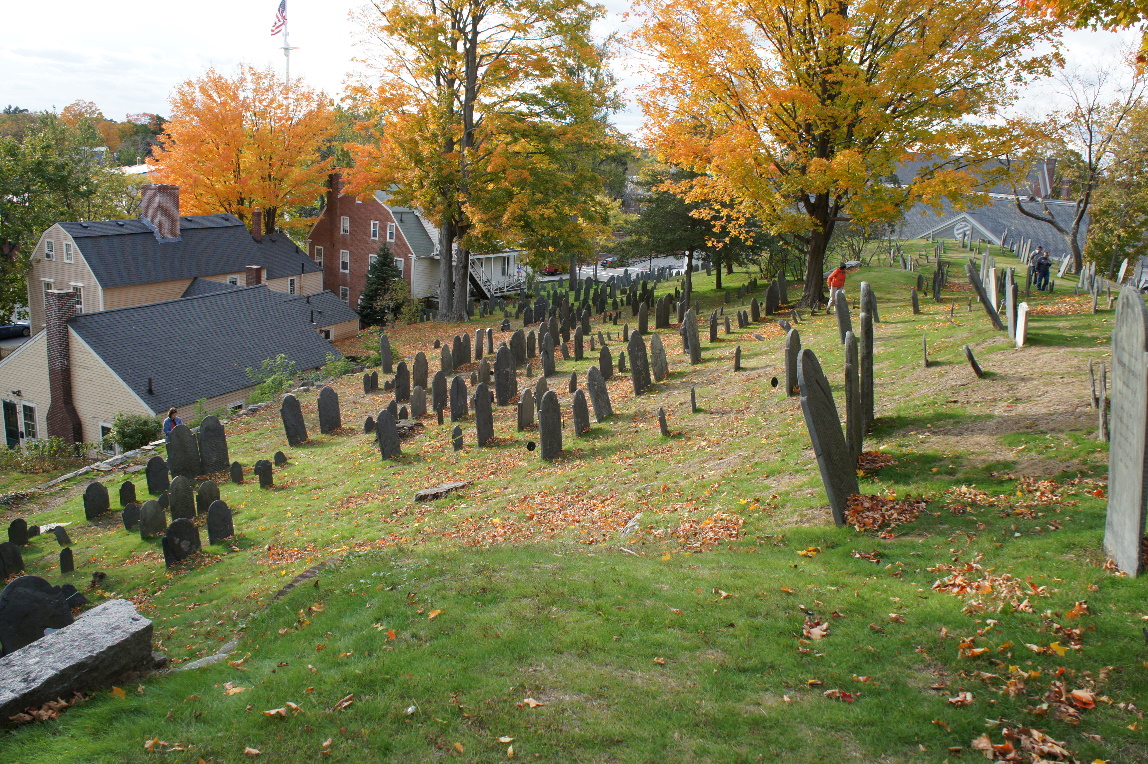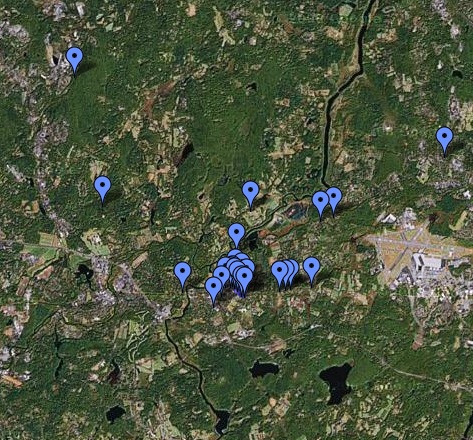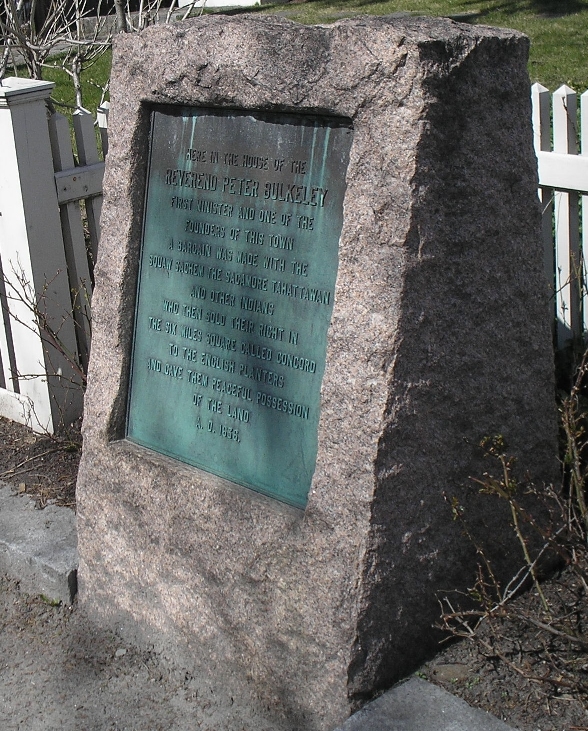Concord was incorporated in the fall of 1635, but the first settlers probably did not arrive until 1636. It was the first inland town of the colony, and unlike Sudbury, which was started along the main trail from Watertown to the Connecticut River valley, there were no trails or roads initially from Cambridge to Concord. So it took a year or two before enough houses were built to allow families to move to Concord. At one point the farmers of Watertown complained that most of the ox carts in Watertown were being used to haul building material to Concord, and the farmers had none to use for their farms. Practically speaking, the town was centered at the mill on a small Mill Brook that ran east-west into the Concord River. The village green with the meeting house was on the north side of the mill dam, with the first dozen house lots on the north and south sides of the mill pond. No road went over the mill dam until the 1750s; the only bridge lay to the east of the pond, on current Heywood St. There were three main roads starting at the mill: Lexington Rd. on the north side of the mill pond heading east; Main St. to the southwest; and Monument St to the north. Geographically (as given in the Concord record books) Concord was divided into three "quadrants", the East Quadrant east of the mill dam, the North Quadrant along Monument St, and the West (or sometimes called the South) Quadrant along Main St. The towns of Acton and Bedford were both carved from the original town of Concord. The first burying ground (Old Hill Burying Ground) was at the back of the meeting house; however a second burying ground was soon started on the side of Main St., probably because there was a superstition in those days that dead bodies should not cross running water. Ten of our ancestors have burial stones in the Old Hill Burying Ground - more than any other cemetery in Massachusetts. [See photo of cemetery at top right.]
There are several prominent people in the history of Concord that were related to us but not direct ancestors. Simon Willard, co-founder of the town with Rev PETER BULKLEY, was the brother of our ancestor MARGERY (WILLARD) DAVIS. Rev. Ezra Ripley, who was minister of the church in Concord and lived in the Old Manse a century after JAMES BLOOD owned the land, was the son of our ancestors NOAH and LYDIA RIPLEY. Samuel Prescott, who rode with Paul Revere on the historic ride to alert the minutemen, was grandson of JONATHAN and REBECCA PRESCOTT. Finally, the Meriam House at Meriam's Corner that was prominent in the Battle of Lexington and Concord, was built by the sons of our ancestor SARAH (GOLDSTONE) MERIAM.
In the following descriptions, the direct ancestors (not including siblings) are given in capital letters. Because there are so many Concord ancestors, the families are arranged alphabetically.
|-Thomas Atkinson
Rebecca Atkinson-|
|-Susanna
THOMAS ATKINSON settled in Concord before December 7, 1636, when he bacame a freeman. He was the brother of THEODORE ATKINSON of Boston (see Boston chapter). THOMAS married Susanna, probably in England, and had four children, three born in Concord and one, REBECCA, probably born in England. THOMAS died in 1646 while the children were still young. The inventory of his estate, taken by Simon Willard, Thomas Brookes, and George Wheeler, included £80 that he still had in England. His wife SUSAN then married William Alline and was still alive when he died in 1659. A letter March 29, 1652, from Robert Adkinson of Timby, Halifax, England, indicates that he was THOMAS' brother, and that THOMAS sold land before going to N.E. "17 years ago this spring". Son John went to live with his uncle THEODORE in Boston, before settling in Newbury. Daughters Susanna and Hannah married the same man, Caleb Brooks, 10 years apart. Daughter REBECCA married JOHN HEYWOOD of Concord.
|-John Ball
|-Nathaniel Ball-|
|-Eleazer Ball -|
Priscilla Ball-| |-Mary
|-Priscilla Wood
JOHN BALL, born in England around 1585, came to Mass. with his sons John and NATHANIEL. John Ball Jr stayed in Watertown for many years, married THOMAS FOX's eldest daughter Elizabeth Fox, and moved to Lancaster where they were both killed during King Philip's War. [yDNA tests of descendents of John Ball Jr of Watertown and NATHANIEL BALL of Concord show they were unrelated, although this could be due to problems with the testing.] JOHN BALL Sr may have lived in Watertown initially, but is listed as being admitted a freeman on the same date in 1650 in both Watertown and Concord. However he is also included in a list of settlers in Concord by 1636. No more is known about the father except that he died in Concord in 1655. NATHANIEL was also admitted a freeman on the same date as his father. He probably married MARY in Massachusetts. They had seven children, five of whom are recorded in Concord but two including ELEAZER not recorded. MARY died in 1669, and NATHANIEL married Mrs. Margery (Knight) Bateman the next year. He is listed in 1666 as having 11 lots in Concord totaling 137 acres, living at E. Bedford road within the present limits of Bedford. ELEAZER was born around 1650 and served under Capt. Wheeler at Groton in garrison service during King Philip's War. He married PRISCILLA WOOD 1675 and they had five children. PRISCILLA is not recorded in Concord, but mentioned as the oldest daughter in ELEAZER's will. When his wife died around 1687, he married Sarah Meriam of Cambridge and had one more child. The daughter PRISCILLA BALL married ISAAC MILLER of Sudbury; see the Sudbury chapter for more on the Miller family.
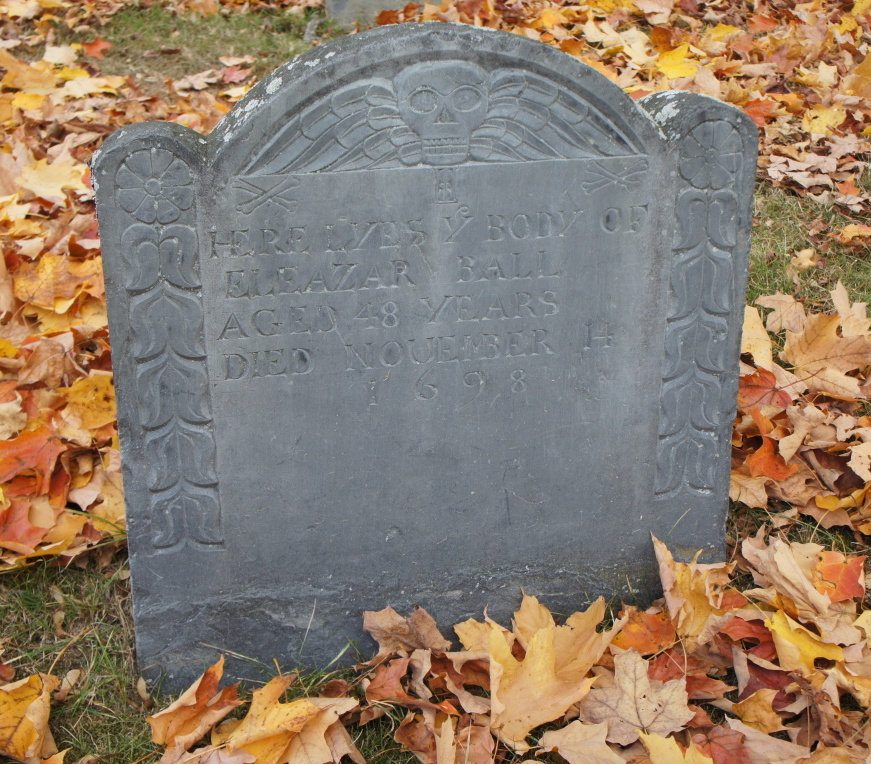
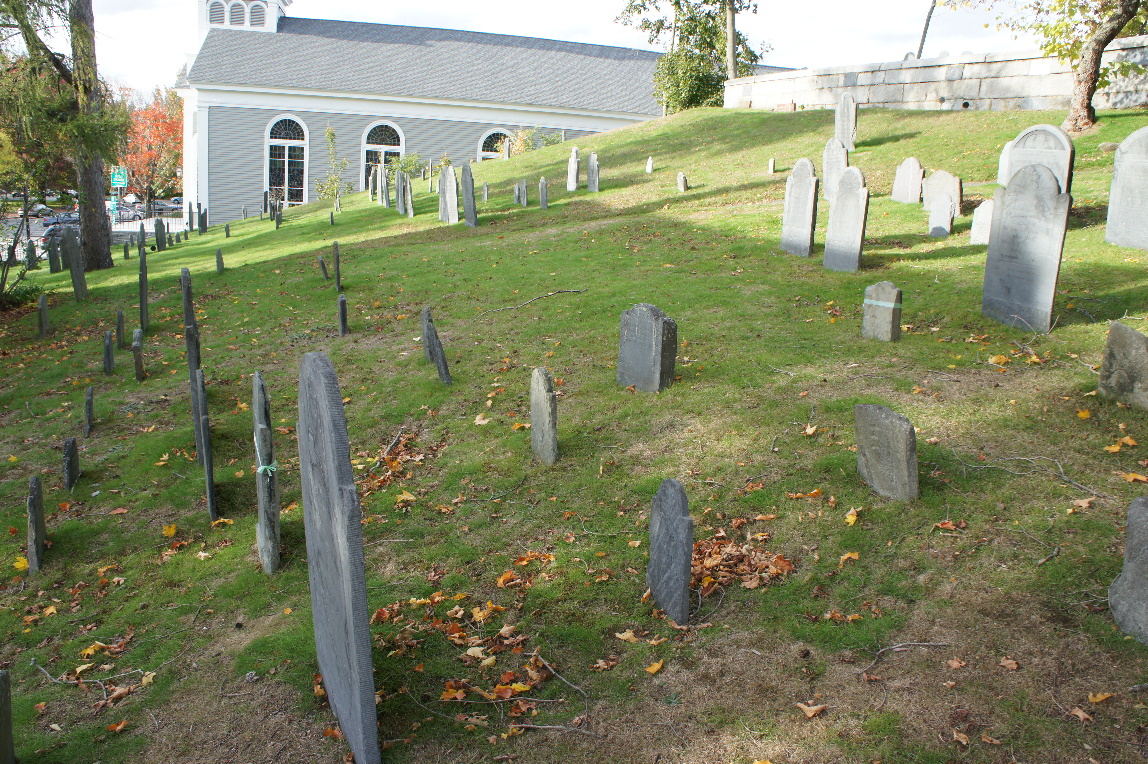
HERE LYES Ye BODY OF | Ball gravestone in
ELEAZAR BALL | Old Hill Burying Ground
AGED 48 YEARS
DIED NOVEMBER 14
1698
|-James Blood
Mary Blood-|
|-Ellen Harrison
JAMES and ELLEN BLOOD and their four children came to Concord in 1639, where their fifth child MARY was born the following year. JAMES became a freeman in 1641, and labeled a yeoman or proprietor. He was a sergeant until 1660 when he requested a dispensation from training. He and his son James Jr. held 12 lots of land totaling 660 acres in 1665. Their home was on a 12 acre lot on Monument St. where the Old Manse is now located. Their daughter MARY married SIMON DAVIS in 1660. Their son Robert married Simon Willard's daughter, and when Simon died he gave her 1000 acres northwest of Concord, which, along with James Jr.'s land became known as "Blood's Farms", and eventually became the town of Carlisle. ELLEN died in 1674 and JAMES died in 1683, both in Concord.
|-Peter Bulkley
|-Edward Bulkley-|
|-Peter Bulkley -|
Rebecca Bulkley-| |-Luciann
|-Rebecca Wheeler
 The Bulkley family was perhaps the most influential family in the early days of Concord, and is one of the most important of our ancestors. Rev. PETER BULKLEY was the founder of Concord along with Simon Willard. He was a wealthy and established minister in England in a family descended from an English Baron. He was born at Woodhill, in Bedforshire, January 31, 1583, educated at St. John's College at Cambridge, and succeeded his father as rector of the Church of All Saints in Odell in 1610. He married JANE ALLEN, aunt of the Lord Mayor of London, in 1613 and their oldest son EDWARD was born in 1614. JANE died shortly after their 11th child was born in 1626. PETER was suspended by the archbishop in 1634 for his refusal to conform to the requirements of the Anglican Church, and he decided it was time to leave. His son EDWARD came over first in 1634 to prepare for the family's arrival, and PETER had time to sell some of his assets and marry his second wife, Grace Chetwood, one month before boarding the "Susan & Ellen" in 1635. He brought £6,000 sterling with him, making him one of the wealthiest people in the colony. He also paid for the passage of a carpenter under an arrangement that the carpenter would build PETER a house and mill. Clearly PETER was going to use his wealth to avoid the rigors of being a pioneer. He moved into an empty house in Cambridge that his son had bought for him, became friends with the new Rev. Shepard of Cambridge, and inserted himself into the political life of the colony. He teamed up with the merchant Simon Willard to orchestrate a new plantation west of Cambridge, the first inland town in the colony. His money certainly helped; the policy then was that 200 acres of land were promised for every £50 invested. Concord was formed in the fall of 1635, and some of the new settlers started living there in 1636, but PETER took his time and waited until 1637 for roads to be developed and his carpenter to finish his house. His home was on 31 acres in the center of town; in fact, when the town bought the land from the Indians, the deed was signed at PETER's home and specified that the land was a square with the edges exactly three miles in the four cardinal directions from that spot. His house was just north of the Mill Brook and to the west of the meeting house and village green. PETER had the carpenter build the mill and mill dam where Main St currently crosses over the brook. PETER also owned other lots including 300 acres in the southeastern part including what is called "Nine Acres Corner".
The Bulkley family was perhaps the most influential family in the early days of Concord, and is one of the most important of our ancestors. Rev. PETER BULKLEY was the founder of Concord along with Simon Willard. He was a wealthy and established minister in England in a family descended from an English Baron. He was born at Woodhill, in Bedforshire, January 31, 1583, educated at St. John's College at Cambridge, and succeeded his father as rector of the Church of All Saints in Odell in 1610. He married JANE ALLEN, aunt of the Lord Mayor of London, in 1613 and their oldest son EDWARD was born in 1614. JANE died shortly after their 11th child was born in 1626. PETER was suspended by the archbishop in 1634 for his refusal to conform to the requirements of the Anglican Church, and he decided it was time to leave. His son EDWARD came over first in 1634 to prepare for the family's arrival, and PETER had time to sell some of his assets and marry his second wife, Grace Chetwood, one month before boarding the "Susan & Ellen" in 1635. He brought £6,000 sterling with him, making him one of the wealthiest people in the colony. He also paid for the passage of a carpenter under an arrangement that the carpenter would build PETER a house and mill. Clearly PETER was going to use his wealth to avoid the rigors of being a pioneer. He moved into an empty house in Cambridge that his son had bought for him, became friends with the new Rev. Shepard of Cambridge, and inserted himself into the political life of the colony. He teamed up with the merchant Simon Willard to orchestrate a new plantation west of Cambridge, the first inland town in the colony. His money certainly helped; the policy then was that 200 acres of land were promised for every £50 invested. Concord was formed in the fall of 1635, and some of the new settlers started living there in 1636, but PETER took his time and waited until 1637 for roads to be developed and his carpenter to finish his house. His home was on 31 acres in the center of town; in fact, when the town bought the land from the Indians, the deed was signed at PETER's home and specified that the land was a square with the edges exactly three miles in the four cardinal directions from that spot. His house was just north of the Mill Brook and to the west of the meeting house and village green. PETER had the carpenter build the mill and mill dam where Main St currently crosses over the brook. PETER also owned other lots including 300 acres in the southeastern part including what is called "Nine Acres Corner".
Rev PETER BULKLEY was minister of the church in Concord for over 20 years, but his religious influence was not confined to Concord. While he still lived in Cambridge, he presided over the trial of Anne Hutchinson, and moderated the 1637 synod in Cambridge. In 1646 he wrote "The Gospel Covenant" , one of the first books and the first important religious book written in America. When President Stiles of Yale read the book a hundred years later he said that he considered BULKLEY one of the three or four most valuable ministers in the early days of the colony. It was said that PETER was strick in his observance of the sabbath, and was an aristocrat, not a democrat. But he was also generous, and often hired a servant or tradesman for a few years, and ended by giving the person a farm to live on their own. When he died in 1659, his estate amounted to £1302, of which £123 was in books (he had previously given part of his library to Harvard College). He had at least 16 children, of which at least four went to Harvard including John, who was in the first graduating class in 1642. He is buried in the Old Hill Burying Ground, in an unmarked grave.
Here in the house of the Reverend Peter Bulkeley first minister and one of the founders of this town a bargain was made with the Squaw Sachem, the Sacamore Tahattawan and other Indians who then sold their right in the six miles square called Concord to the English planters and gave them peaceful possession of the land A. D. 1636.
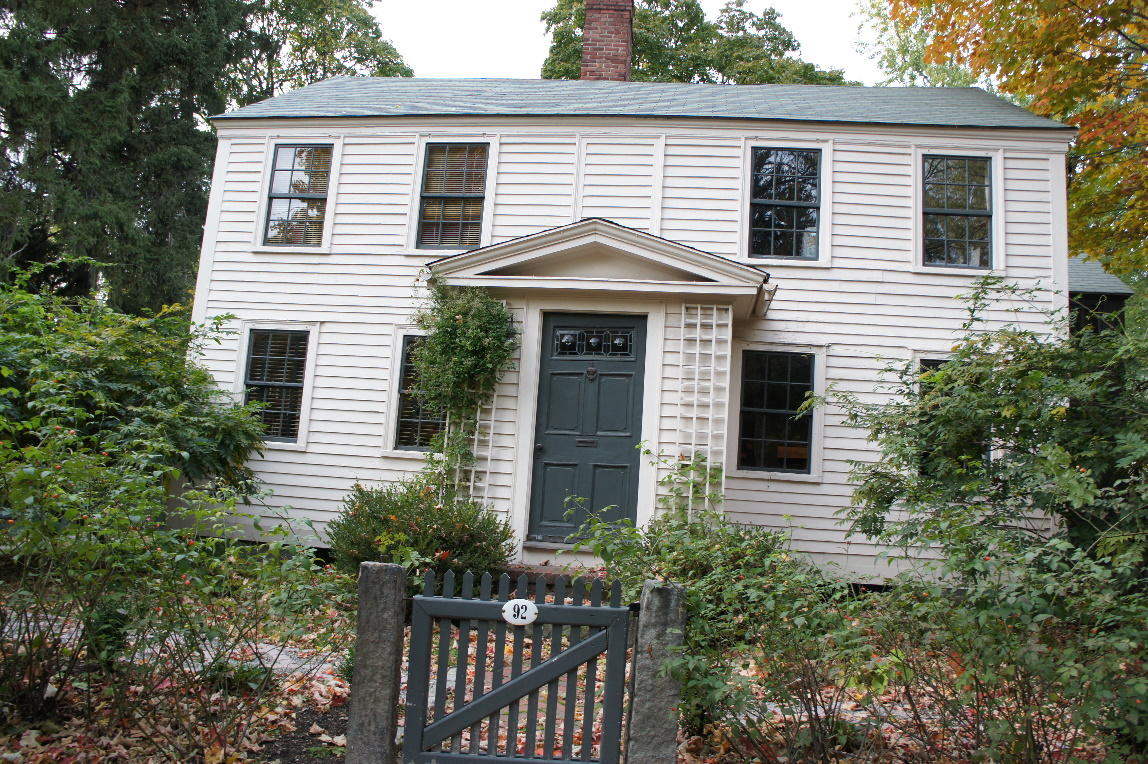 Rev EDWARD BULKLEY came to America in 1634 as a young, 20-year-old man, newly educated as a minister. He was admitted to the fellowship of the First Church in Boston on March 22, 1634/5 as a "singleman". At some point he married LUCIANN, and their first child PETER was born in Concord Nov 3, 1641. In 1642 he settled in Marshfield, south of Scituate, where he was the 2nd pastor of the Church of Marshfield. He became a freeman of the Plymouth Colony in 1644. He returned to Concord in 1658, and when his father died he took over as minister of the church in Concord in 1660. He lived in a house on Main St, where the Concord Academy grounds now are, and his house still stands, although it was moved in 1826 to its present location at 92 Sudbury Rd. At one point he became a stockholder of an iron works company that built a dam over the Assabet River at what is now Westvale in West Concord. EDWARD did not have quite the same religious reputation that his father did. One of his few sermons that ended up in print is practically unreadable because every sentence contains a reference to a verse of scripture in the Bible. Our ancestor JOHN HOAR was once fined £10 in 1688 for criticizing EDWARD, saying that the blessing EDWARD had given was no better than vain babbling. However his preaching had at least one good effect: legend says that during King Philip's War Indians met on Pomciticut Hill to decide who to attack next, Sudbury or Concord. One of them said Concord was led by too powerful a man (Rev EDWARD BULKELEY) and the Great Spirit would be offended if Concord was harmed, so they attacked Sudbury. EDWARD lived 81 years, and died while visiting one of his daughters in Chelmsford. He is said to be buried in the Old Hill Burying Ground with his father.
Rev EDWARD BULKLEY came to America in 1634 as a young, 20-year-old man, newly educated as a minister. He was admitted to the fellowship of the First Church in Boston on March 22, 1634/5 as a "singleman". At some point he married LUCIANN, and their first child PETER was born in Concord Nov 3, 1641. In 1642 he settled in Marshfield, south of Scituate, where he was the 2nd pastor of the Church of Marshfield. He became a freeman of the Plymouth Colony in 1644. He returned to Concord in 1658, and when his father died he took over as minister of the church in Concord in 1660. He lived in a house on Main St, where the Concord Academy grounds now are, and his house still stands, although it was moved in 1826 to its present location at 92 Sudbury Rd. At one point he became a stockholder of an iron works company that built a dam over the Assabet River at what is now Westvale in West Concord. EDWARD did not have quite the same religious reputation that his father did. One of his few sermons that ended up in print is practically unreadable because every sentence contains a reference to a verse of scripture in the Bible. Our ancestor JOHN HOAR was once fined £10 in 1688 for criticizing EDWARD, saying that the blessing EDWARD had given was no better than vain babbling. However his preaching had at least one good effect: legend says that during King Philip's War Indians met on Pomciticut Hill to decide who to attack next, Sudbury or Concord. One of them said Concord was led by too powerful a man (Rev EDWARD BULKELEY) and the Great Spirit would be offended if Concord was harmed, so they attacked Sudbury. EDWARD lived 81 years, and died while visiting one of his daughters in Chelmsford. He is said to be buried in the Old Hill Burying Ground with his father.
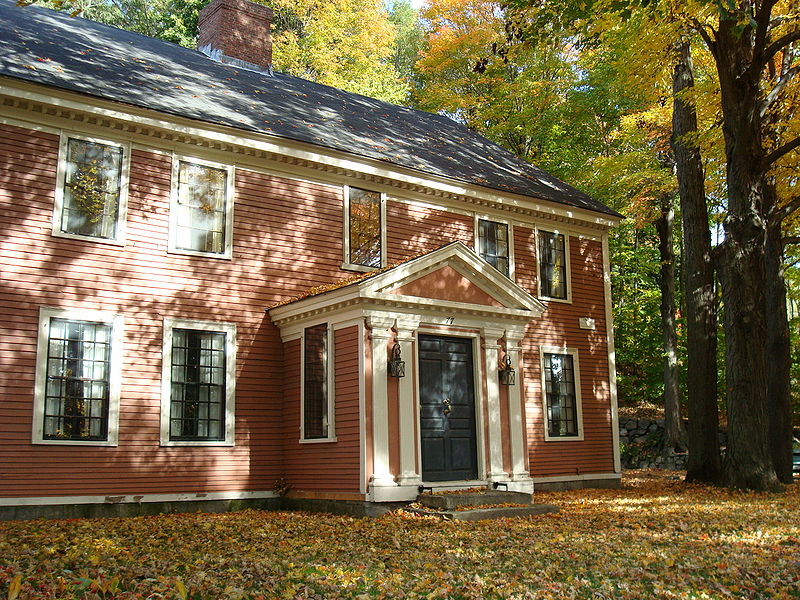 There is some confusion about Major PETER BULKLEY, born 1641, son of EDWARD, because there was another Peter Bulkley, born 1643, who was the half-brother of EDWARD. That Peter was a doctor who married a Margaret and ended up with some of his siblings and mother in Fairfield, Connecticut. EDWARD's son PETER married REBECCA WHEELER and remained in Concord. The main problem occurs in a book about the graduates of Harvard College by John Sibley, which describes PETER BULKLEY, class of 1660, and Peter Bulkley, class of 1662, as being the same person. Samuel Eliot Morison clears up the confusion in his book "The founding of Harvard College". Our ancestor did in deed graduate from Harvard in 1660, married REBECCA WHEELER in 1667 and had four children born in Concord including REBECCA in 1681. PETER was educated for the ministry, and preached at Braintree in 1669-70, but he was never ordained. Instead he made his fame from public service: from 1673 to 1676 he was the deputy or representative from Concord to the General Court, and the last year he was chosen as Speaker. In that last year he was a member of a committee to prepare a response to the King of England over complaints of the heirs of Mason and Gorges. He was appointed with William Stoughton to go to England and give the response to the King. The trip lasted two months, and Charles II declared that they had "demeaned themselves, during their attendance, with good care and discretion." PETER received a grant of £150 as a gratuity for his effort. For the next eight years, 1677-1686, PETER was annually chosen Assistant (equivalent to a modern state senator). During that time he was appointed a captain of the foot company in Concord, and then given command of one of the two regiments of the Middlesex militia with the title "Major PETER BULKLEY, Esq." He was involved with the "million purchase" in New Hampshire, and was granted 1000 acres of land near the Rehoboth line. When King Charles II dissolved the Massachusetts Bay Colony in 1684, PETER was prominent in the reorganized government. He was appointed one of the 15 Councillors under Joseph Dudley, President of New England, and made Provost-Marshal of New Hampshire. Finally he was made an Associate Judge of the Superior Court. However PETER did not like what was going on in the new government, and was described by Edward Randolph as "stupified and drown in melancholy, and almost uselesse, being seldom with us." May 25, 1688, he "died of melancholy". His house still stands at 77 Lexington Rd, although it was extensively or entirely rebuilt in 1725 by Reuben Brown and is now called the Reuben Brown House.
There is some confusion about Major PETER BULKLEY, born 1641, son of EDWARD, because there was another Peter Bulkley, born 1643, who was the half-brother of EDWARD. That Peter was a doctor who married a Margaret and ended up with some of his siblings and mother in Fairfield, Connecticut. EDWARD's son PETER married REBECCA WHEELER and remained in Concord. The main problem occurs in a book about the graduates of Harvard College by John Sibley, which describes PETER BULKLEY, class of 1660, and Peter Bulkley, class of 1662, as being the same person. Samuel Eliot Morison clears up the confusion in his book "The founding of Harvard College". Our ancestor did in deed graduate from Harvard in 1660, married REBECCA WHEELER in 1667 and had four children born in Concord including REBECCA in 1681. PETER was educated for the ministry, and preached at Braintree in 1669-70, but he was never ordained. Instead he made his fame from public service: from 1673 to 1676 he was the deputy or representative from Concord to the General Court, and the last year he was chosen as Speaker. In that last year he was a member of a committee to prepare a response to the King of England over complaints of the heirs of Mason and Gorges. He was appointed with William Stoughton to go to England and give the response to the King. The trip lasted two months, and Charles II declared that they had "demeaned themselves, during their attendance, with good care and discretion." PETER received a grant of £150 as a gratuity for his effort. For the next eight years, 1677-1686, PETER was annually chosen Assistant (equivalent to a modern state senator). During that time he was appointed a captain of the foot company in Concord, and then given command of one of the two regiments of the Middlesex militia with the title "Major PETER BULKLEY, Esq." He was involved with the "million purchase" in New Hampshire, and was granted 1000 acres of land near the Rehoboth line. When King Charles II dissolved the Massachusetts Bay Colony in 1684, PETER was prominent in the reorganized government. He was appointed one of the 15 Councillors under Joseph Dudley, President of New England, and made Provost-Marshal of New Hampshire. Finally he was made an Associate Judge of the Superior Court. However PETER did not like what was going on in the new government, and was described by Edward Randolph as "stupified and drown in melancholy, and almost uselesse, being seldom with us." May 25, 1688, he "died of melancholy". His house still stands at 77 Lexington Rd, although it was extensively or entirely rebuilt in 1725 by Reuben Brown and is now called the Reuben Brown House.
|-Dolor Davis
|-Simon Davis-|
Mary Davis-| |-Margery Willard
|-Mary Blood
DOLOR DAVIS came to Cambridge in 1634 with his brother-in-law, Simon Willard (see the Cambridge chapter for more details). DOLOR and MARGERY had a son SIMON born in Cambridge. In 1635 when the General Court granted to PETER BUCKLEY and Simon Willard and others the land for Concord, Simon moved to Concord immediately and DOLOR followed the next year. However perhaps because of his business as a carpenter or house builder, DOLOR moved frequently. In 1638 he appeared in Duxbury, and in 1640 in Barnstable. There he became a freeman in 1646, surveyor of highways in 1652, and constable in 1654. He acquired over 120 acres of land in Barnstable, including his house lot which was the northern most lot on the east side of the ancient mill-way, not far from the water mill built by the first settlers. But by 1655 he was back in Concord buying land and called "husbandman", and he sold the last of his land in Barnstable in 1658. He was one of the signers of the order creating Groton in 1655 and was made a selectman, even though he probably never actually lived in Groton. MARGERY probably died in Concord, at which point DOLOR moved back to Barnstable where he remarried in 1671. When he died in 1673, the bulk of his estate was land in Concord valued at 125.5.7 pounds. His descendents include three Massachusetts governors: John Davis, John Davis Long, and George Dexter Robinson.
SIMON DAVIS lived in Concord all of his adult life. His homestead, off Monument St north of the river, was near his father's house on a farm given to him by his father. In King Philip's War he was under Captain THOMAS WHEELER when the Captain was injured, and SIMON took charge of the men. In 1689 he received a commission as lieutenant, and in King Williams War (the first of the French and Indian Wars) he became a captain in charge of 40 troopers and 30 foot soldiers defending the frontier from Dunstable to Marlborough. In 1689, 1690, 1692, and 1705 he was a Deputy to the General Court. In 1660 he married MARY BLOOD, who also lived off Monument St, and had seven children including MARY in 1663.
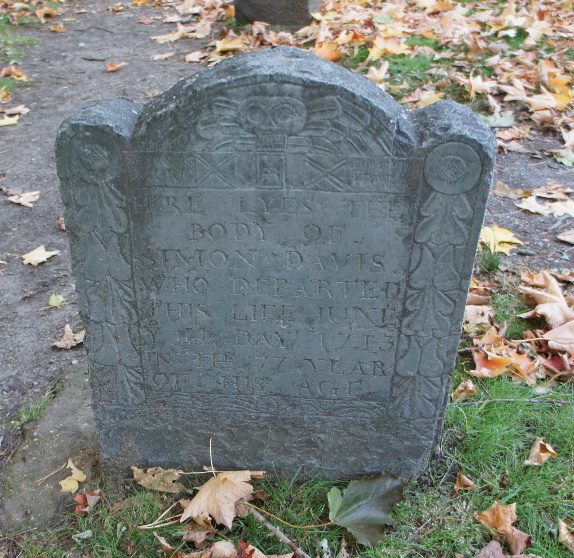
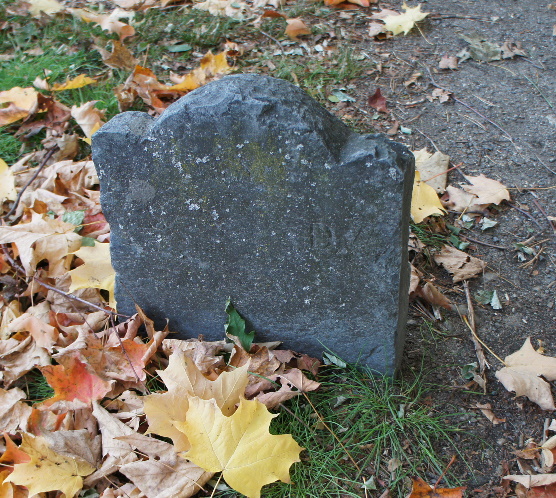
MEMENTO FUGIT MORI HORA HERE LYES THE BODY OF SIMON DAVIS WHO DEPARTED THIS LIFE JUNE ye 14 DAY 1713 IN THE 77 YEAR OF HIS AGE
|-Thomas Fox
|-Eliphalet Fox-|
|-Abraham Gibson |-Samuel Fox-| |-Rebecca
Rebecca Gibson-| |-Thomas Fox-| |-Mary Wheeler
|-Esther Fox-| |-Ruth Knight
|-Rebecca French
THOMAS FOX is on a list of settlers who arrived in Concord by 1640, although he probable came in 1638 with his sister Thomasine. He originally lived on an 8 acre houselot on the north side of what is now Lexington Road, just to the west of NATHANIEL BALL. Hawthorne Lane now runs south from this property across the Mill Brook on a bridge that is called Fox's Bridge. In 1653 THOMAS was granted 106 acres in the West Quarter on Old Bedford Road, where he lived when he died in 1658. THOMAS probably married REBECCA in Concord. They had three children born in Concord: twins Elizabeth and Mary (Mary only lived 3 weeks), and son ELIPHALET, born around 1644.
REBECCA died in 1647, and seven months later THOMAS married Hannah Brooks and had six more children. When THOMAS died in 1658, his will gave his house and lands to ELIPHALET, and money to all of his other children. In the will he mentioned "Brethren Moses Wheate". Older books use this as evidence to say REBECCA was the sister of Moses and Joshua Wheate, who came to Concord in 1635. The Wheate brothers acquired two house-lots adjacent to each other on the road to Bedford, and just five lots from THOMAS FOX. However the term "Brethren" actually comes from the fact that Moses married THOMAS' sister Thomasine. Hannah moved to Connecticut with the younger children, where she married John Lester. One son moved to Woburn. Elizabeth married NATHANIEL BALL's brother John Ball Jr., and moved with him to Lancaster where they were killed in King Philip's War.
ELIPHALET was the only son to stay in Concord. In 1665, when he was old enough to receive his inheritance, he owned 106 acres in 14 lots in Concord. He moved back to his father's original home site, where he built a new house further up the hill. He became neighbor to JOHN HOAR, who bought the land immediately to the west. In 1858, Bronson Alcott bought both houses and combined them to form the Orchard House, site of Louis May Alcott's "Little Women", which is still standing. ELIPHALET married MARY WHEELER on October 26, 1665, just 23 days after his sister Elizabeth married. ELIPHALET and MARY had six children including SAMUEL born in 1670. MARY died seven days after giving birth to Benoni. ELIPHALET then married Mary (Stone) Hunt two years later and had two more sons. Both of them married Meriam women, and one, Nathaniel, moved to Dracut, MA, where his descendents are still living 300 years later on his original grant. ELIPHALET became a freeman in 1690, married a third wife Mary Bishop in 1702, and died in 1711. ELIPHALET gave homes to four of his sons: John and Nathaniel on Cambridge Turnpike, and Stephen and Benoni on Old Bedford Road.
Unfortunately, we know nothing more about succeeding Fox generations in Concord other than their births, marriages, children, addresses, and deaths. There is no mention of them in the Concord history books. SAMUEL was given the Fox home on the road to Bedford. SAMUEL married RUTH KNIGHT in 1693, had nine children including THOMAS, born in 1706, and SAMUEL died in 1733. THOMAS was called a housewright, lived in a house on the east side of Old Bedford Road, and in 1740 married REBECCA FRENCH, who lived on the same street less than a mile away just over the line in Bedford. THOMAS and REBECCA had two daughters, Hannah and ESTHER, born in 1743. ESTHER married ABRAHAM GIBSON of Stow. Their oldest child was born in Stow, but the next four children including REBECCA born in 1765, were all born in Concord. Then, after five generations of the Fox family in Concord, they moved to Fitchburg and eventually Lunenburg.
|-Lieut. Joseph French
|-Joseph French-|
Rebecca French-| |-Elizabeth Knight
|-Elizabeth
Lieut. JOSEPH FRENCH was the last of our ancestors to immigrate from England to Concord. He wasn't even born until 1649, after most of our other Concord ancestors were already in Concord. JOSEPH was in Concord by 1672, when he married ELISABETH KNIGHT of Topsfield. They had eight children born in Concord including JOSEPH Jr. There is a curious entry in the will of Robert Meriam in 1676 giving "Joseph French, whoe formerly lived with me; 20 acres of land to be layed out where he now liveth". JOSEPH must have lived with Robert Meriam when he first arrived in Concord, perhaps before he married. He then moved to Robert's land by the hiway going from the Town to Billerica, where he paid rent. Robert's will gives this land and house to JOSEPH provided that the rent for the property still be given to Robert's wife as long as she lives.
JOSEPH's home, on Concord Rd. in the current town of Bedford, was a garrison house in case of Indian attack. It was 42' x 20', and in later years an ell 20' x 16'. The upper story projected over the lower on the side facing the highway, and in this projection were loopholes through which the flintlock muskets could be put and discharged in case of attack. The door was thickly studded with wrought iron nails to prevent the Indians from splitting it. There was also a large iron locker upon it. When the family worked on the back lots they kept a musket near at hand. The garrison was destroyed in the September gale of 1815. The "ell" was built in 1693 to accommodate a daughter, who married Richard Wheeler. This building still exists as 455 Concord Road, Bedford. JOSEPH was selectman of Concord in 1689 and 1700-1703. His name heads the list of petitioners, May 1, 1728, "for the erection of a new town to be called Bedford", and also heads the list of the laymen who founded the church in 1730. In his will JOSEPH provided for his wife, including articles of produce from the farm and five barrels of cider annually. JOSEPH JR proved an unfaithful executor and years were spent in litigation. We know little about the son. He married ELIZABETH and had at least one daughter REBECCA. He lived on his father's land, and in 1731 and 1732 gave and sold some of it to REBECCA's first husband James Carey. When Carey died, REBECCA married THOMAS FOX of Concord.
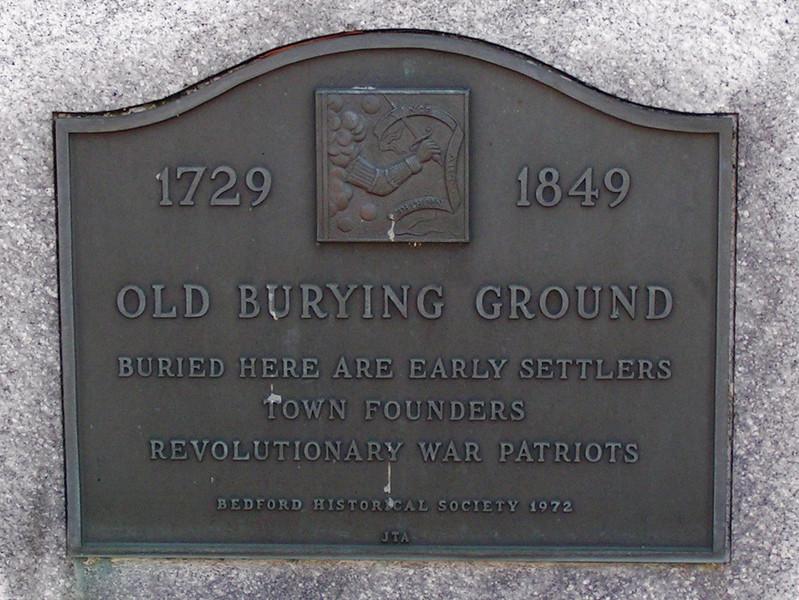
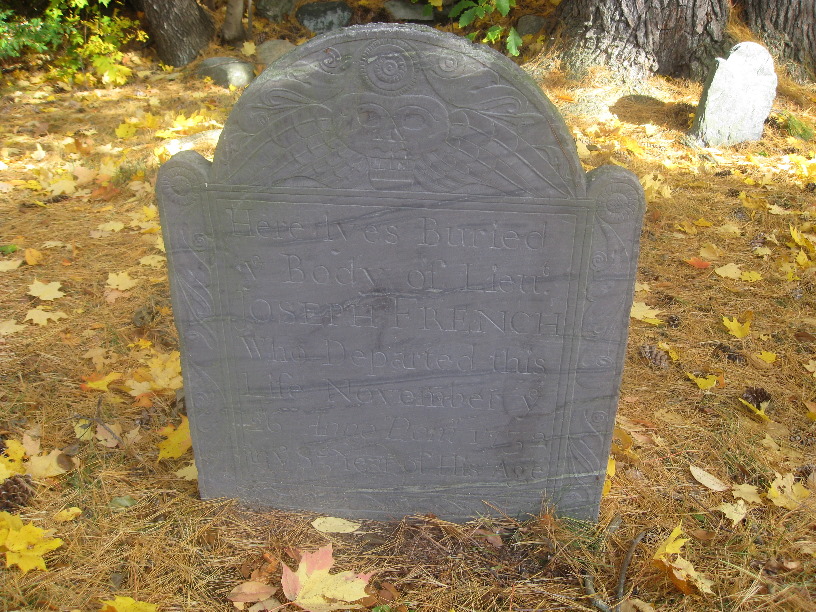
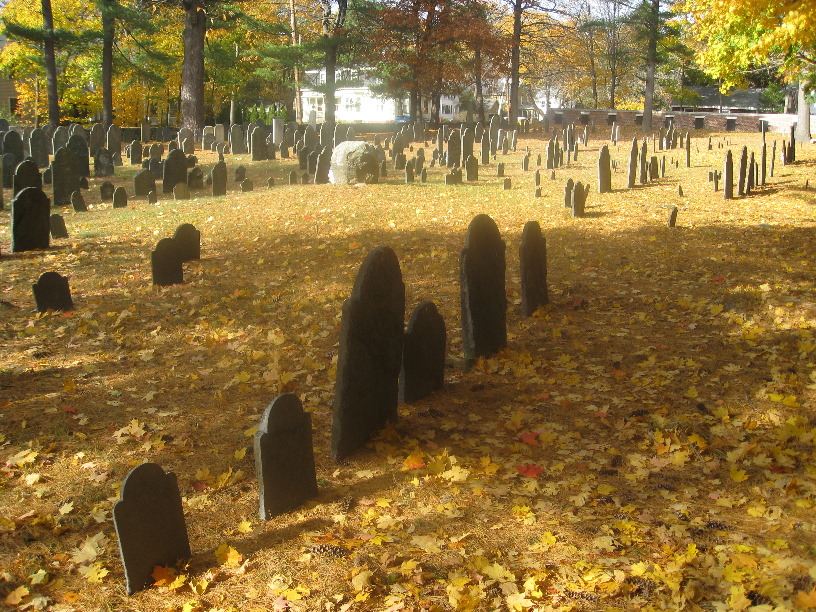
Here lyes Buried ye Body of Lieut. JOSEPH FRENCH Who Departed this Life November ye 26 Anno Domni 1732 in ye 83d Year of His Age
|-Nathaniel Harwood
Mary Harwood-|
|-Elizabeth
NATHANIEL HARWOOD came to Boston sometime before 1665, perhaps in 1645 when his brother John came. Two other brothers, Thomas and Robert, and a sister Hannah also came to Boston during this time. Hannah married Thomas Wheeler, the son of ancestor GEORGE WHEELER. NATHANIEL married Elizabeth in Boston, and their first child was born in 1665 in Boston. They then moved to Concord, where NATHANIEL was a cordwainer. He was made a freeman in 1690. Four more children were born in Concord, including MARY, born Feb 5, 1676, who married THOMAS MERIAM of Cambridge (Lexington). Read about them in the Lexington Chapter. NATHANIEL and ELIZABETH died in Concord in 1716 and 1715, respectively.
|-John Heywood
|-Deacon John Heywood-|
|-Samuel Heywood-| |Rebecca Atkinson
|-Jonas Heywood-| |-Sarah Blodgett
John Prescott Heywood-| |-Elizabeth Hubbard
|-Ann Prescott
The Heywood family lived for 5 generations in Concord, a span of over 150 years. JOHN HEYWOOD first appears in the records of Concord with his marriage to REBECCA ATKINSON of Concord in 1656. However there is confusion in the records over the spelling of the last name, sometimes being Haywood or Haward. There was a George Heaward or Hayward that came to Concord in 1635 with his wife Mary, and who had a son John born in 1640. This does not appear to be our ancestor, because if he were, then he would be only 16 when he married REBECCA. Also there is a record of John marrying Anna White in 1671. So I am assuming our ancestor JOHN HEYWOOD is not a son of George Hayward. Unfortunately, this means we know nothing about our ancestor's parents or whether he was born in England.
What we do know about JOHN is that he was a freeman in 1670 and constable in 1676. In 1666 he took over the running of an ordinary (tavern) from his neighbor Sargeant William Buss. JOHN lived on a four acre lot to the west of the burying ground on Main St., and Buss had the next lot of seven acres. In 1970, and again in 1972, JOHN received a license "to keep a house of entertainment for strangers for nights lodgings, beer and sider" (see Alfred Sereno Hudson's "History of Concord Vol I", page 182). The tavern, or JOHN's house, was just south of the burying ground on Main St. By 1665 JOHN acquired 385 acres in 13 lots in the South quarter. With REBECCA he had 5 children including JOHN in 1662. Their first and last babies both died young; REBECCA died one week after the last baby was born, and the baby died one week after her. Four months later JOHN married Sarah Symonds and had 10 more children before Sarah died. Over the span of 32 years, JOHN had 15 children.
We know little more about the next generation, Deacon JOHN HEYWOOD Jr., other than he was one of the early deacons of the Concord church, town selectman from 1705-1708 and town treasurer from 1709-1714. He married SARAH BLODGETT of Woburn in 1687, and they had 12 children. Their son SAMUEL HEYWOOD, born in 1687, was also a deacon, town selectman from 1720-1723, 1727-1728, and 1730-1748, and a town clerk from 1731-1748. He married ELIZABETH HUBBARD of Concord in 1710, and likewise had 12 children. Their son JONAS HEYWOOD was born in 1721, and also was a town selectman from 1755-1759 and 1762-1770, and town clerk for the same years. In 1746 JONAS was a corporal in a company of 50 men sent to Boston on an alarm about a possible attack from a French fleet. In 1778 JONAS HEYWOOD, Esq. was on several committees chosen by the town to hire officers needed for various campaigns during the Revolutionary War. He joined the Social Circle in Concord, along with two of his sons. He is listed in the Sons of the American Revolution database as being a Captain, buried in the Hill Cemetery in Concord. JONAS is also listed in the 1790 U.S. Census for Massachusetts as a head-of-household for Concord with five people in the house. JONAS married ANN PRESCOTT and had five children, and they both lived into the 19th century. Their house was a few rods west of the train station, between the station and Main St.
Finally we come to the last generation in Concord: JOHN PRESCOTT HEYWOOD, born Sept 13, 1754. He lived only a short while in Concord, before moving to Lunenburg to live with his great uncle John Prescott. JOHN PRESCOTT HEYWOOD's grandfather SAMUEL was the oldest child in his family, whereas his brother John was the youngest son, some 18 years younger than SAMUEL. John married and moved to the new town of Lunenburg by 1729. He became an important figure in the community, being a selectman, moderator, and deacon. He had 7 children: his only son Silent was the oldest, but must have died young as there is no further record of him. Four of his daughters died in a 4-day period in 1740. The ramaining two daughters married in 1751 and 1761, and John's first wife died and he married Silence White in 1760. We can only speculate what caused JOHN PRESCOTT HEYWOOD to move in with John, but we know that in 1777, John wrote his will naming JOHN PRESCOTT HEYWOOD as his executor, and bequething his estate to his wife, two daughters, and "adopted son John Prescott Heywood". See the Lunenburg (Lancaster) chapter to read his entire story.
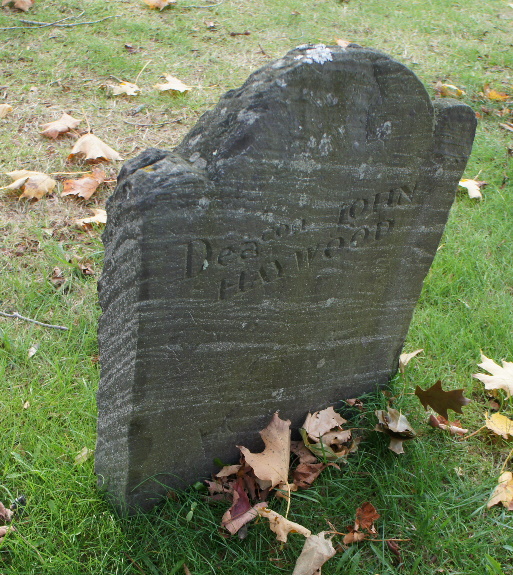
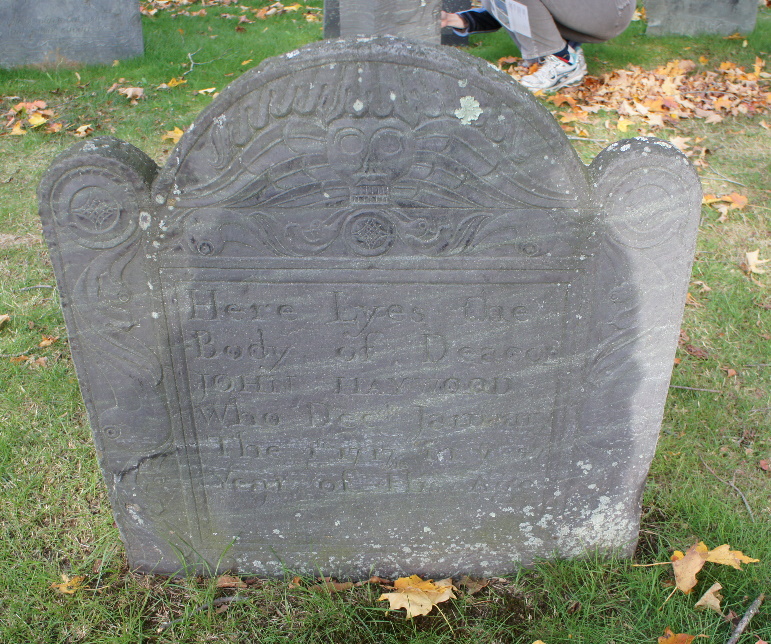
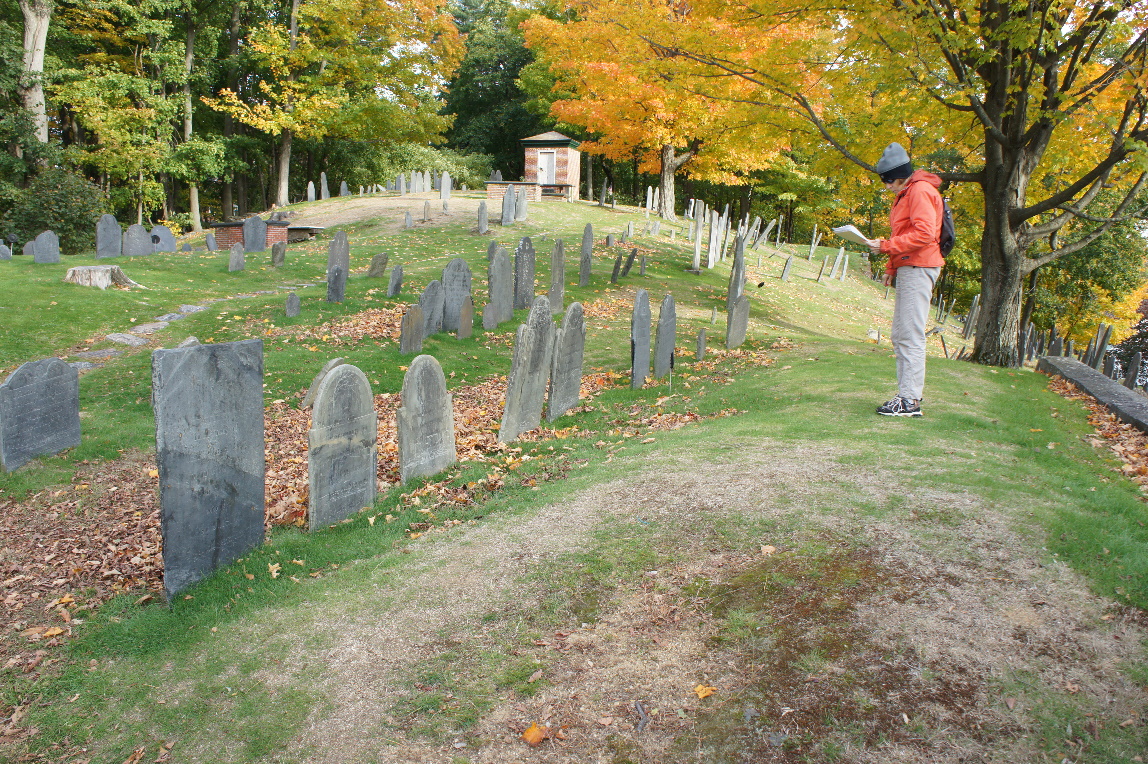
Deacon JOHN | Here Lyes the | Heywood graves
HAYWOOD | Body of Deacon |
(footstone) | JOHN HAYWOOD |
Who Dec'd January
the 1st 1717/18 in ye 57
Year of His Age.
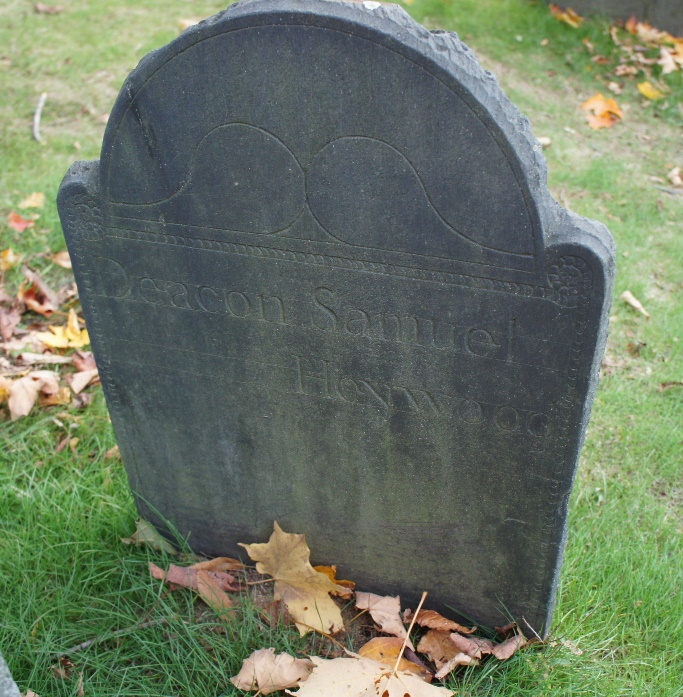
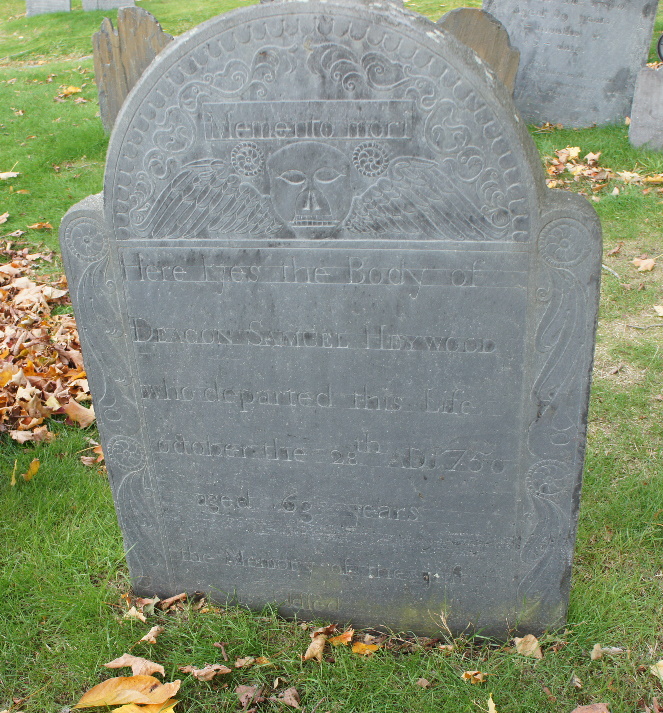
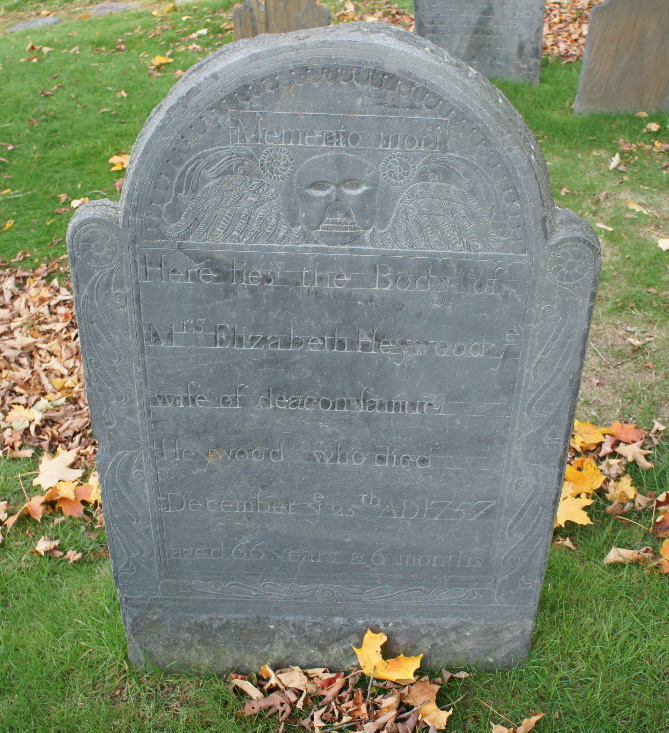
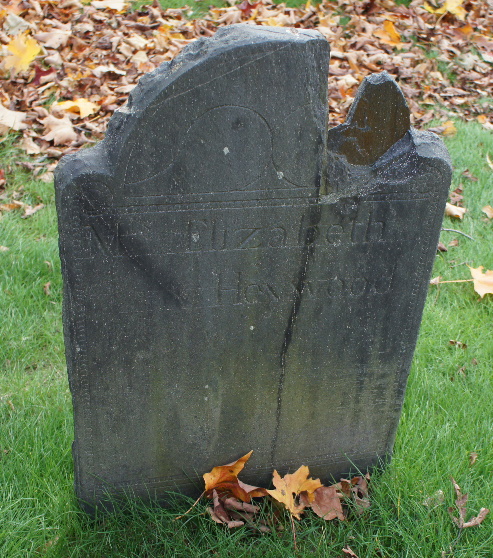
Deacon Samuel | Momento mori | Momento mori | Elizabeth
Heywood | ------------ | ------------ | Heywood
(footstone) | Here lyes the Body of | Here lies the Body of | (footstone)
Deacon Samuel Heywood | Mrs Elizabeth Heywood ye
who departed this Life | wife of deacon Samuel
october the 28th AD 1750 | Heywood who died
aged 63 years | December ye 25th AD 1757
the Memory of the just | aged 66 years & 6 months
is blessed |
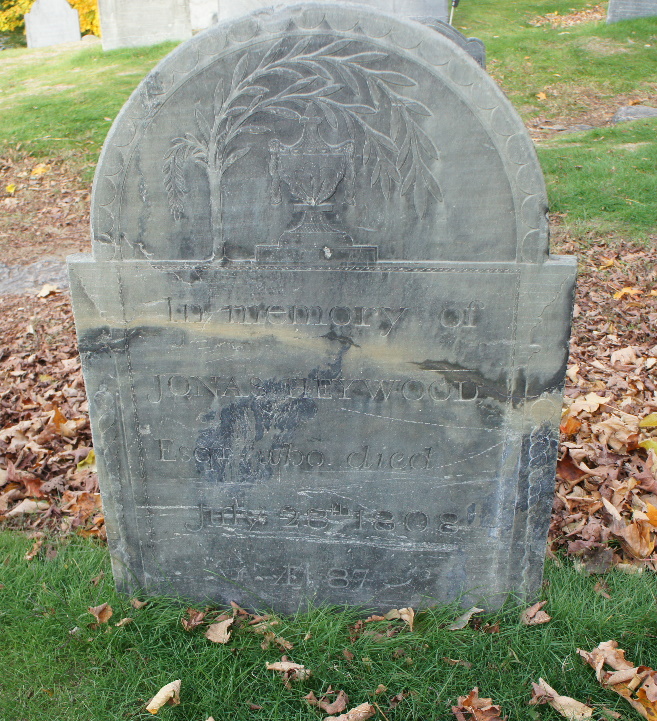
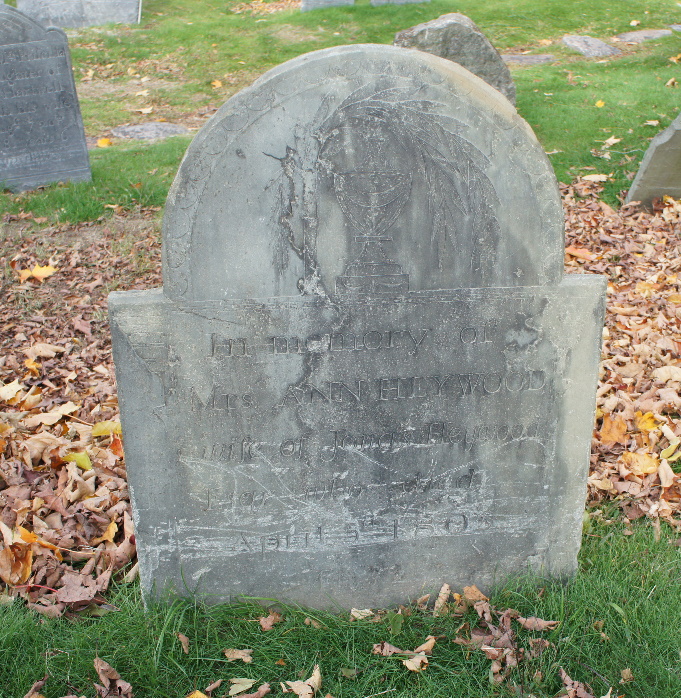
In memory of | In memory of
JONAS HEYWOOD | Mrs ANN HEYWOOD
Esqr who died | wife of Jonas Heywood
July 28th 1808 | Esqr who died
AEt 87 | April 5th 1805
| AEt 72
|-John Hoar
Elizabeth Hoar-|
|-Alice
JOHN HOAR originally came to Braintree, and worked as a lawyer all his life. By 1643 he lived in Scituate where he married ALICE and had ELIZABETH born about 1650 (see the Hingham chapter). In 1659 he moved to Concord, the first lawyer practitioner in Concord, where he owned over 300 acres beyond the Assabet River near Annursnuc in the western part of town. In 1671 he sold most of this land to Edward Wright, and received in part Wright's land in the East quarter of Concord where JOHN built his home. This house was still standing when Bronson Alcott bought the property in 1858. Alcott combined THOMAS FOX's old house with JOHN HOAR's to form a single house he called the Orchard House, site of Louis May Alcott's "Little Women", which is still standing and kept as a Museum. JOHN died in Concord on April 2, 1704; we know nothing more about ALICE other than her name.
JOHN HOAR is famous for his involvement in King Philip's War. Concord was deeply affected by the war even though it was never attacked. Legend says that during the war Indians met on Pomciticut Hill (what is now Summer Hill in Maynard, on our ancestor TIMOTHY GIBSON's future land) to decide who to attack next, Sudbury or Concord. One of them said Concord was led by too powerful a man (Rev EDWARD BULKLEY, our ancestor) and the Great Spirit would be offended if Concord was harmed, so they attacked Sudbury. However Concord men did fight in the war, including Capt. THOMAS WHEELER, his son Thomas, and SIMON DAVIS. Capt. THOMAS WHEELER died from wounds he suffered during an ambush. There is another, humanitarian, side of the war that Concord participated in, and our ancestor JOHN HOAR was the central participant. Rev. John Eliot had converted to Christianity some of the Indians in and around Concord, and formed an Indian village named Nashoba for 58 Christian Indians. When the war broke out, there was much distrust of any Indian, and the Colonial authorities decided to remove all of the Christian Indians throughout the colony to Deer island in Boston Harbor. However an arrangement was made for the Nashoba Indians to be placed under the inspection of JOHN HOAR who was charged to keep the Indians employed and preserved from harm. JOHN built a house and workshop for them near his own house ["A Collection of Historical and Other Papers" by Grindall Reynolds, 1896, page 150, presumes that JOHN HOAR was living then on Lexington St, site of the current Orchard House. "History of the Praying Indians" by Gookin said "...a large and convenient work-house for the Indians near his own dwelling, which stood about the midst of the town, and very nigh the town watch-house."] where they were under close surveillance. But when the Indians burned Lancaster on Feb 10, taking the minister's wife Mrs. Mary Rowlandson prisoner, some people who disliked this arrangement sent for Captain Mosely, who was known for his antipathy toward Indians. The Captain led his troops to JOHN's house, and after a day of confrontation whereby JOHN refused to allow them access to the Indians, they forceably broke down the door and hauled the Indians off to Charlestown and eventually Deer Island. The Indians lost all their possessions, and few of them returned to Nashoba when the war was over. [It sounds very similar to the internment of Japanese Americans during WWII.]
JOHN HOAR continued to figure prominently in the war. The Indians contacted Boston with a ransom demand for Mrs. Rowlandson. On May 2, JOHN HOAR met the Indians at Wachusett Hill where he successfully negotiated her release, and later the release of most of the other white captives. Mrs. Rowlandson kept a diary of her travails with the Indians, which was published and became famous. Here is an excerpt out of "The Name of War: King Philip's War and the Origins of American Identity" by Jill Lepore, 1998:
"When the Council delegation arrived, Mary Rowlandson asked to see John Hoar: 'I begged them to let me see the English man, but they would not.' During a break in negotiations, however, she was finally allowed to meet with him, and learned of the possibility of her imminent release. Afterward she addressed her captors eagerly: 'I now asked them, whether I should go home with Mr. Hoar? They answered No.' At the end of another day of negotiations, James Printer visited Rowlandson and Hoar to inform them of the likelihood of Rowlandson's release. The next morning according to Rowlandson, the Indians 'called their General Court (as they call it) to consult and determine, whether I should go home or no: and they all as one man did seemingly consent to it, that I should go home; except Philip, who would not come among them.' Mary Rowlandson was released on May 2 and returned to Boston on May 3."
|-William Howe
|-Samuel Howe-|
Mary Howe-| |-Mary
|-Mary Nutting
WILLIAM HOWE was born in England in 1629, and immigrated to Lynn with his parents in 1635. His father died when he was just 10 years old. When he reached his 20s, he married MARY and moved to Concord (we don't know in which order). Their six children were born in Concord, starting with SAMUEL born Oct 14, 1654. Sadly, four of the children died as infants. After their last child was born in 1665, they might have lived for awhile in Chelsford or Marlborough, but he died in Concord in 1676. The inventory of his estate amounted to £35. Mary lived in Concord until she died in 1695. Their son SAMUEL first married Mary Woolie in 1673. After two children, Mary died and SAMUEL married MARY NUTTING March 26, 1678. The NUTTING's had moved to Concord when the town of Groton was burned in 1676 during King Philip's War. They had ten children born in Concord, including MARY in 1682. Around 1700, the family moved to Plainfield, Connecticut where WILLIAM was one of 38 who signed the agreement to incorporate the town on Nov. 13, 1699. In the Indian war of 1704 SAMUEL was a Sergeant in the train-band company. That year he is also listed as a member of a church committee overseeing the design of the new meeting-house. In 1720 he is mentioned as a carpenter. He left a will October 30, 1724, in Plainfield, while his wife lived until 1727. Daughter MARY may not have gone with them to Plainfield; she married JAMES RUSSELL of Lexington in 1706.
|-Jonathan Hubbard
Elizabeth Hubbard-|
|-Hannah Rice
The Hubbard family came through Watertown to Wethersfield, Connecticut, where JONATHAN was born in 1659, and eventually ended up in Hadley, Massachusetts (see the Connecticut chapter). JONATHAN HUBBARD's mother, MARY MERIAM, was GEORGE MERIAM's daughter. While JONATHAN was still a child, he went to live with his great uncle Robert Meriam in Concord, perhaps when his mother died, or during King Philip's War. The SAMUEL RICE family from Marlborough also lived in Concord during the War, and JONATHAN undoubtedly met his future wife HANNAH RICE then. They married in 1681, and were still living with the Meriam's when Robert died in 1682. His will bequethed his house (on Walden St) to his wife, and gave "to my Cosen Jonathan Hubard hoe liveth with me twenty shillings". When his wife MARY died in 1693, she gave "to my cousin Jonathan Hubbard who liveth now in my hous with me all my housinge and lands in Concord" (she gave all of her other cousins, i.e., nieces and nephews, money). JONATHAN was town Treasurer from 1700 to 1708, and Selectman in 1703. JONATHAN and HANNAH had 11 children. Their oldest daughter, Mary, was an ancestor of President Calvin Coolidge. Their sixth child, ELIZABETH, married SAMUEL HEYWOOD of Concord. JONATHAN died in 1728 and HANNAH lived another 19 years. They were both buried in the Old Hill Burying Ground. The current Hubbard St. starts at Walden St. and probably runs through or on the edge of JONATHAN's property.
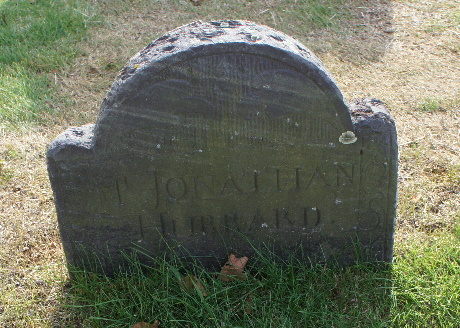
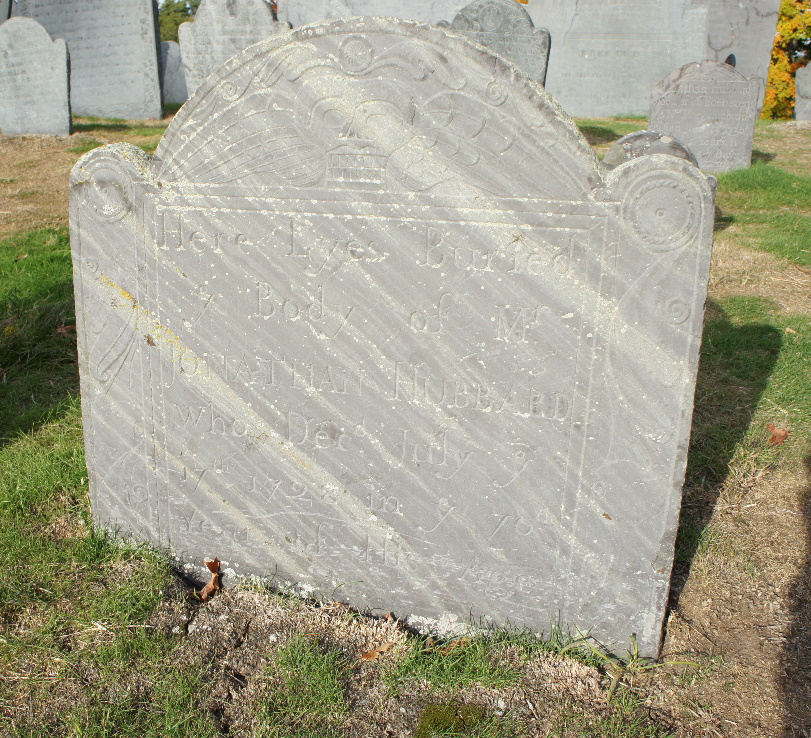
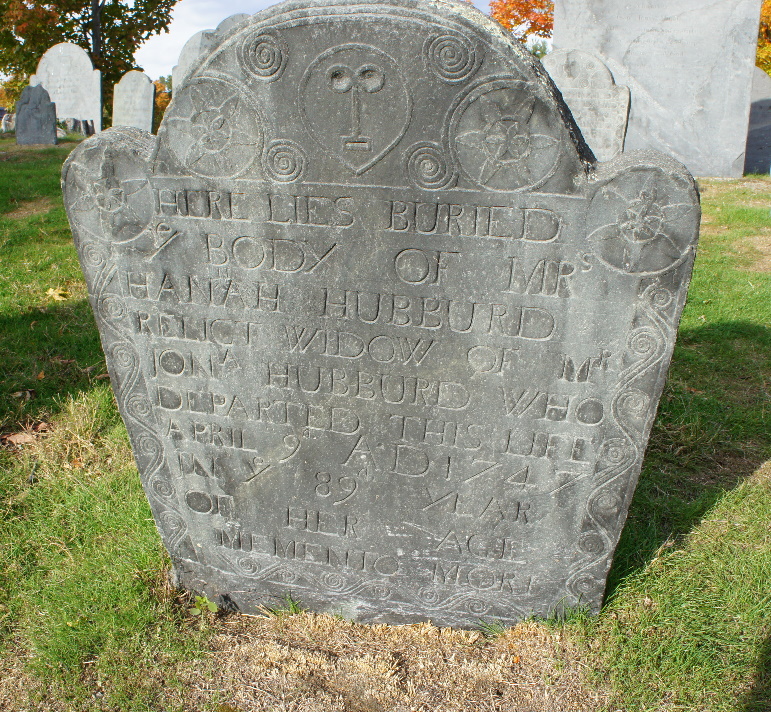
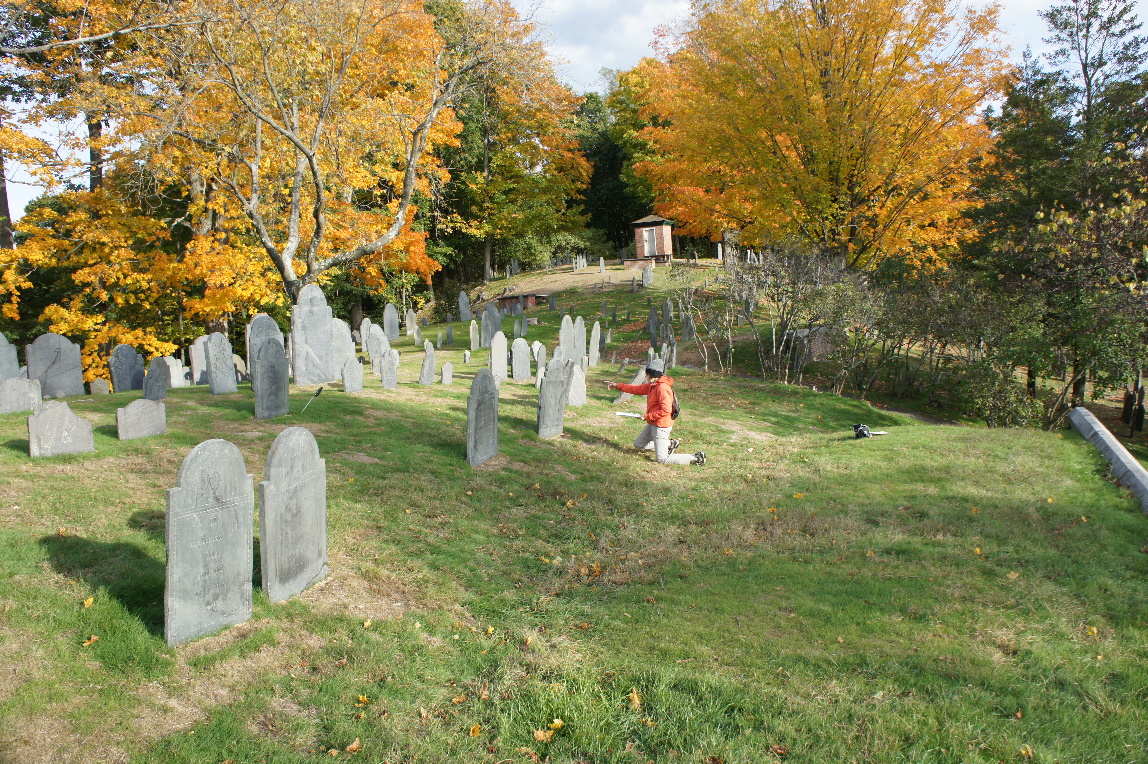
Jonathan | Here Lyes Buried | HERE LIES BURIED | Sharon in
Hubbard | ye Body of Mr. | YE BODY OF MRS | front of
(footstone) | Jonathan Hubbard | HANNAH HUBBURD | Hubbard graves
Who Decd. July ye | RELICT WIDOW OF MR
17th 1728 in ye 70th | JONA HUBBURD WHO
Year of His Age | DEPARTED THIS LIFE
| APRIL 9 AD 1747
| IN YE 89 YEAR
| OF HER AGE
| MEMENTO MORI
|-Joseph Meriam -|
Joseph Meriam-| |
|-Sarah Goldstone |
|-(parents in England)
Robert Meriam -|
|
|-George Meriam -|
Mary Meriam -|
|-Susanna Raven
Three Meriam brothers came to Concord around 1639: JOSEPH, Robert, and GEORGE. Only two of them are actual ancestors, but the third one played a prominent role by raising an ancestor, so I will describe all three Meriams here.
JOSEPH MERIAM was a clothier in England. He came on the ship "Castle" of London, arriving in Charlestown in July, 1638. He had a financial stake in the ship, and was party to several lawsuits afterward about money. In Concord he became a freeman March 14, 1638/9. He probably lived on the southwest corner of the current Walden and Heywood Sts, next to his brother GEORGE. JOSEPH died after only 3 years in Concord. He had seven children with his wife SARAH GOLDSTONE. His son JOSEPH Jr and at least five others were born in England; their last child John was born in Concord six months after he died. His will left his estate to SARAH until their children reached 21. SARAH married another of our ancestors JOSEPH WHEELER, who eventually bought all of the land that the children had inherited. Read more about SARAH below in the section on the WHEELERs.
JOSEPH's son John bought the land that is now called Meriam's Corner, and built his home there in 1666. His son Joseph built his own house on that land in 1705, which still stands and is called the Merriam House. The house and corner is now a part of the Minute Man National Historical Park.
JOSEPH MERIAM Jr. married SARAH STONE of Cambridge in 1653, and at some point moved to Cambridge Farms, the part of Cambridge that became the town of Lexington. Read more about him in the chapter on Lexington. Curiously, he is buried in Concord, and is the oldest gravestone in Concord. Perhaps this was because his land was only three miles east of his brother John's land at Meriam Corner, and he was more connected to Concord than to Cambridge Farms.
Robert resided first in Charlestown, where he had a house and warehouse, woodland, marsh, and cow commons in 1638. He then moved to Concord where he became a freeman 13 March 1638/9 and ran Concord's first store on his 23 acres of land on the current Walden St, where the Unitarian Church now sits. He was chosen as a deacon of the church, and served as town clerk and as representative to the General Court. He had no children of his own, but he helped raise his brother JOSEPH's children after JOSEPH died in 1641. JOSEPH FRENCH also lived with him for awhile, as did his grandnephew JONATHAN HUBBARD, MARY MERIAM's son.
GEORGE MERIAM and his wife SUSANNA sold six acres of land in England in 1638 before coming to Massachusetts. At least four children were born in England (three of whom died in England) and five were born in Concord. Nothing more is known about SUSANNA. GEORGE was admitted a freeman on June 2, 1641, and by 1655 owned 239 acres in 15 lots. His home was on the current Walden St near Heywood St. When GEORGE died in 1675, his will gave his home with 30 acres to his son, while his five daughters received all of the other land. His daughter MARY MERIAM, who is our ancestor, is not mentioned in the will, which might mean that she had already died. Her last child was born in 1672 in Hadly, but there is no record of her death in Hadley. There is, curiously, a record of her death in Concord on August 10, 1646, which I can not explain other than to think that it is in error. Note that there is another ancestor also named MARY MERIAM who is the great-granddaughter of the JOSEPH MERIAM Jr. mentioned above. Read about her in the Lexington Chapter.
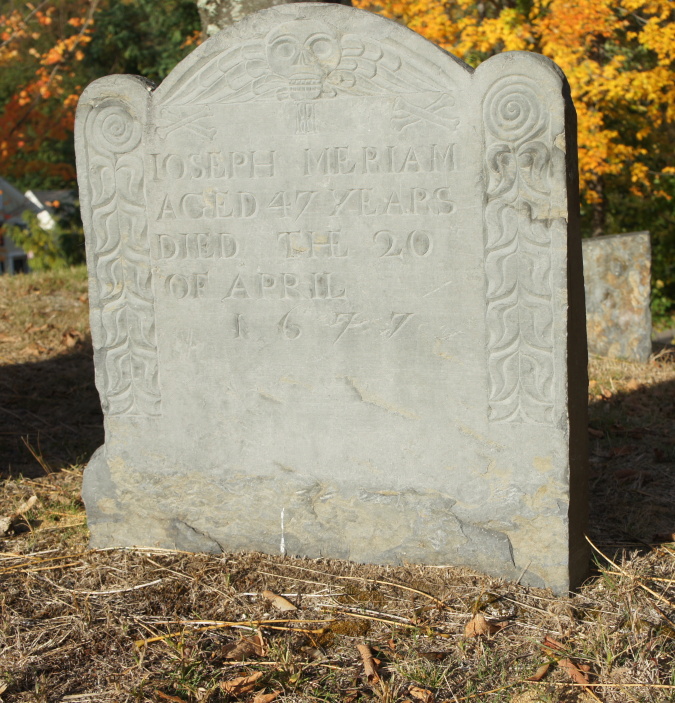
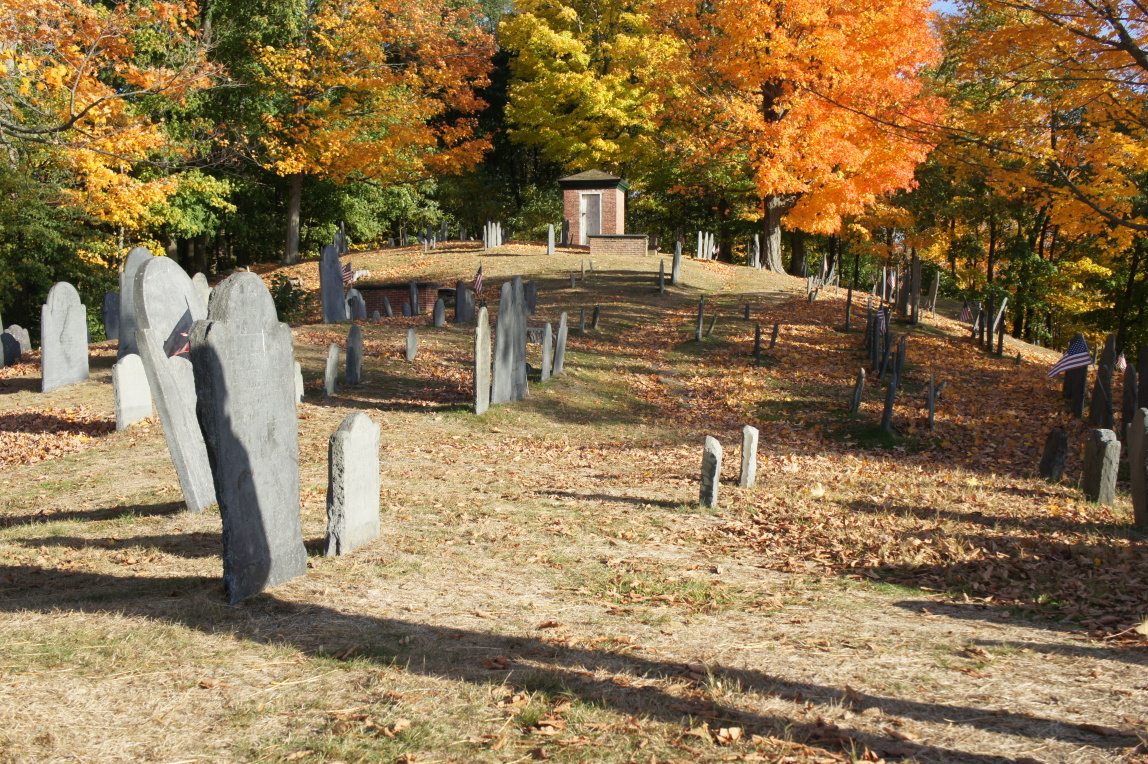
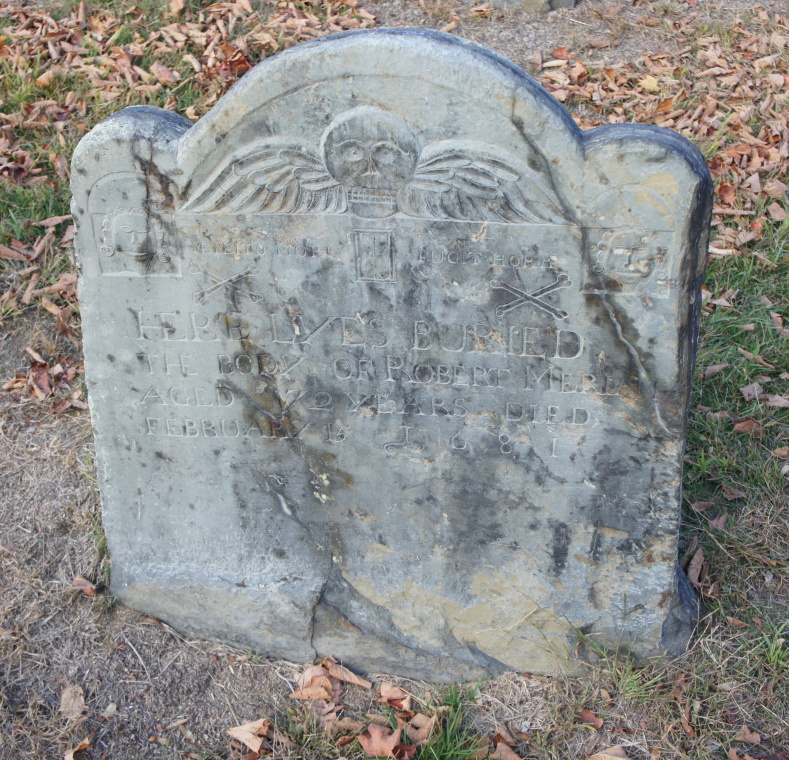
JOSEPH MERIAM | Old Hill Burying Ground | Memeito Mori Fugit Hopa
AGED 47 YEARS | Joseph Meriam's grave | HERE LYES BURIED
DIED THE 20 | is the small stone 2nd | the body of Robert Meriam
OF APRIL | on the left | aged 72 years died
1677 | | february 15 1681
|-Jonathan Prescott
|-Dr. Jonathan Prescott-|
|-Dr. John Prescott-| |-Elizabeth Hoar
Ann Prescott-| |-Rebecca Bulkley
|-Anne Lynde
The story of the Concord Prescott ancestors actually starts in Lancaster, where JONATHAN PRESCOTT was one of the first two babies born (see the Lancaster chapter). He grew up in Lancaster, was described as a blacksmith and farmer, and was a constable there in 1673, but moved to Concord during King Philip's War and lived in Concord the rest of his life. He was unique among our ancestors for having four wives: 1) Dorothy (1670-1674), 2) ELIZABETH HOAR (Dec 23, 1675 - Sep 25, 1687), 3) REBECCA (WHEELER) BULKLEY (1689-1718), and 4) Ruth Brown (1718-1721). He had three children with Dorothy: twins, one named Jonathan, who were probably born premature 9 months after the marriage, and they both died within two days. The third child was named Samuel. With ELIZABETH he had six children, including JONATHAN Jr. born in 1677. ELIZABETH died nine days after the birth of her last child. When JONATHAN Sr. and REBECCA married, the combined household included JONATHAN PRESCOTT Jr., aged 12, and REBECCA BULKLEY, aged 8, who married each other in 1701.
JONATHAN Sr. shows up in the records of Lancaster several times during King Philip's War. Shortly after the town was destroyed in Feb, 1675 by an Indian attack, he signed a petition along with his father and others, requesting carts from the colony to facilitate the survivors moving to other, safer towns (like Concord). Later that spring, after his father-in-law JOHN HOAR negotiated for the release of Mrs. Rowlandson, JONATHAN was sent with two other men to meet with Indians about the release of other captives. Finally JONATHAN deeded his house in Lancaster "known by the name of the Rye field" to his son Samuel, four days before Samuel married Esther Wheeler, grand-daughter of GEORGE WHEELER. In Concord, JONATHAN served the town as a selectman in 1709, and as a representative or deputy numerous times: 1692, 1693-5, 1697-9, 1712, and 1713. He bought a house on Main St. from George Wheeler in 1678, which was one of the Concord garrison houses during the War and which JONATHAN had probably been renting. He later added Edward Bulkeley's land further up Main St, and in 1693 he was granted the old road (probably the current Keyes Road) to the east and north of the burying ground and between the cemetery and his house. In 1691 JONATHAN Sr. and Joshua Wheeler built a dam on Sudbury Road called the Swamp Bridge. He acquired much outlying land, and was one of the largest landholders in Concord. I have not found any reference to him serving in the militia, but he is called "Capt" in his later years. The earliest use of that title was 1709, when his son Benjamin was bying to take over the job of minister. Capt Prescott offered to pay settlement expenses if the town selected his son, and he stepped down from his position as moderator during the selection. Another person was chosen, and Benjamin ended up the minister in Salem. In 1717, a tax assessor's list shows that Capt Jonathan Prescott has 2 horses, 2 oxen, and 2 cows and a total assessment of £16. One final curious tidbit: when Peter Bulkeley, Esq. died in 1688, he left among his papers a bill from Jonathan for services as a physician and as a blacksmith. This bill was certainly paid in full since Jonathan proceeded to marry Peter Bulkeley's widow.
Dr. JONATHAN PRESCOTT Jr. was one of the first doctors of Concord (although it looks like his father practiced before him). We know very little about his life. He married REBECCA BULKLEY in 1701, had eight children, and died in 1729. Sons JOHN and Peter graduated from Harvard College and became a doctor and a lawyer. Son Abell also became a doctor, and his son Dr. Samuel Prescott, was the famous patriot who rode with Paul Revere to warn the people that the British were coming. Abell's descendents also include President George H. W. Bush and President George W. Bush. In 1717 the tax assessor showed Capt. Jonathan Prescott Jr. had 2 horses, 2 oxen, 4 cows, and 20 sheep with an assessment of £17 and a "faulty tax" (assessed on trademen and blacksmiths) of £5. In Concord records of births, he is denoted as "Dr." for first children through Charles, born in 1711; "Capt." for the two born in 1713 and 1716; and "Major" for Abell born in 1718. He has a long epitaph on a monumental slab in the South Burying Place:
Here lyes the remains of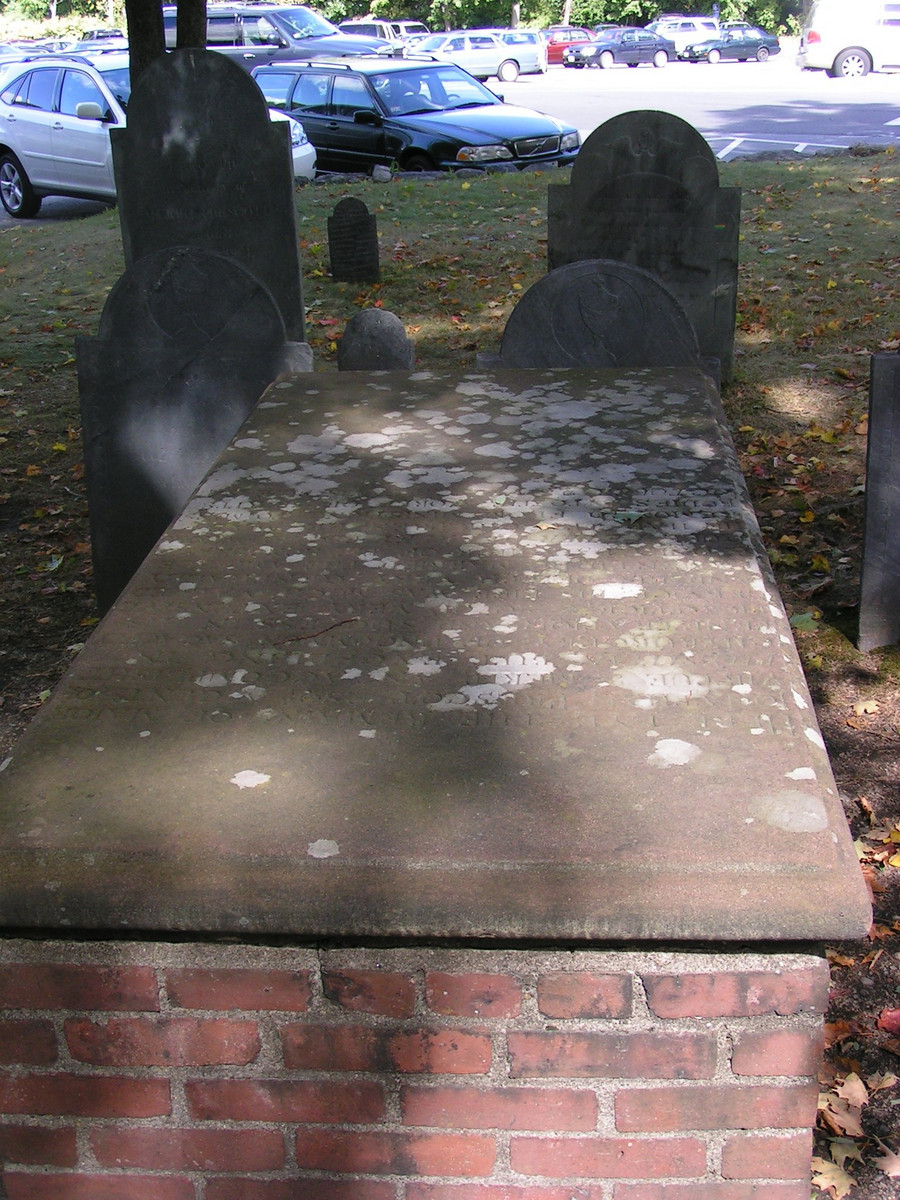 Major JONATHAN PRESCOTT, Esc.,
a gentleman of virtue and merit, an accomplisht physitian,
but excelling in chirurgery.
Of uncommon sagacity, penetration, and success in his practice,
and so of very extensive service.
But his life was much valued, and his death very generally lamented.
He married the amiable and only daughter of the
Honorable Colonel Peter Bulkley, Esq.,
by whom he had ten children.
He was removed from minitring to men's bodies, to the world of spirits,
October 28th, 1729, AEtatis suae 54.
Major JONATHAN PRESCOTT, Esc.,
a gentleman of virtue and merit, an accomplisht physitian,
but excelling in chirurgery.
Of uncommon sagacity, penetration, and success in his practice,
and so of very extensive service.
But his life was much valued, and his death very generally lamented.
He married the amiable and only daughter of the
Honorable Colonel Peter Bulkley, Esq.,
by whom he had ten children.
He was removed from minitring to men's bodies, to the world of spirits,
October 28th, 1729, AEtatis suae 54.
Dr. JOHN PRESCOTT was a doctor like his father. After graduating from Harvard College in 1727, he studied medicine from his father and became a respected doctor. He married ANNE LYNDE of Saybrook, Connecticut on Nov 25, 1730 in Lunenburg, MA. She was probably living with her sister Susannah, who had married a descendent of Simon Willard, the co-founder of Concord. Her husband became the preacher at Rutland, where he had relatives, but was killed by Indians. Susannah married the new preacher, and they moved to Lunenburg in 1728. ANNE and JOHN lived in Concord and had five children, although the first one only lived a week. JOHN enlisted and in 1740 he joined an expedition to Cuba. Great Britain declared war against Spain in 1739, and an American regiment of 3600 men was raised. Five companies of 100 men each came from MA, including one under the command of Capt. JOHN PRESCOTT. They sailed Sep 23, 1740 and was off "Don Maria Bay" the following Feb. The expedition was a complete failure, with only 50 men returning to MA in 1742 (only 3 out of 15 from Concord). After his return, JOHN was sent by the government to England, and there treated with great respect as a Colonel. He died in London of smallpox in 1743. ANNE had an annual pension from the English government for his services, which she collected for over 50 years. She remained in Concord and never remarried. Her daughter ANN, born in 1733, married JONAS HEYWOOD sometime after JOHN died. Her grave is next to her father-in-law's grave in the South Burying Place.
In Memory of MRS. ANN PRESCOTT, wife of Col. John Prescott, who died May 12, 1795; AEt. 88.
|-Joseph Wheeler
Rebecca Wheeler-|
|-Sarah Goldstone
|-George Wheeler
Mary Wheeler-|
|-Katherine Pin
|-Thomas Wheeler
Deliverance Wheeler-|
|-Ruth Wood
The Wheeler name was rampant in the town of Concord: in 1640, there were 35 such families in Concord. This obviously has led to much confusion as to who is related. We have three Wheeler ancestor families that emigrated from England by 1640: JOSEPH, GEORGE, and THOMAS. They may have all been brothers. There are extensive records in England detailing the family of GEORGE back several generations, and those records indicate that he had seven brothers including ones named Thomas and Joseph. However there is nothing else to tie them together. Meanwhile there are several wills that link THOMAS with a brother Timothy and an uncle Obadia and his 5 sons, all of whom ended up in Concord.
We have many Concord ancestors, so it is not surprising that there is alot of intertwining of the various family lines and intersections with historical figures. The JOSEPH WHEELER family is right at the center of the spider web, and not only because of the connection with the other Wheelers. His wife's first husband was our ancestor JOSEPH MERIAM (and grandfather of the man who built the house at Merriam's Corner that played a role in the Battle of Lexington and Concord. The daughter married our ancestor PETER BULKLEY, grandson of the founder of Concord. And when he died, she remarried ancestor JONATHAN PRESCOTT, father of the man who married her daughter and great grandfather of Dr. Samuel Prescott who rode with Paul Revere to warn that the British were coming.
JOSEPH WHEELER was made a freeman in Concord May 13, 1640. He is in the records often from signing almost every petition made in behalf of the town in its early days. His house lot containing 20 acres was on the south side of the mill pond near that of GEORGE WHEELER, and might have been the house lot of JOSEPH MERIAM, first husband of his second wife. In 1655 he owned 29 lots totaling 357 acres. In 1662 he petitioned the General Court for a grant of 200 acres as payment for trading with the Nashoba Indians, but the petition was refused. In 1668 he was granted 610 acres on the Chelmsford line "lying in the form of a triangle, the point towards the northwest and extending southwest to Nashoba (Sudbury) and southeast to Nagog Pond". Also that year he was on a committee to make a contract for a new meeting house. JOSEPH married Elizabeth and had two sons born in Concord, but sadly she died May 19, 1642, followed on July 10 and July 18 with the deaths of her two sons. JOSEPH remarried Mrs. SARAH (GOLDSTONE) MERIAM, and they had two daughters including REBECCA born in 1645. See more about SARAH in the section on the MERIAMs above.
Second of our Wheeler ancestors was GEORGE WHEELER, who first appears in the Concord records in 1638 and whose signature is on many documents of the town, attesting to his prominence in local affairs. He was wealthy and ended up with many parcels of land, including most of Rev Peter Bulkley's estate. GEORGE lived on an 11 acre parcel in the center of town, on the south side of the mill pond and the east side of Main Street stretching almost to Thoreau St. His will goes on and on as he lists many different parcels and designates which of his three sons should receive each parcel. To his five daughters and his grandchildren he gave only money.
The third of our Wheeler ancestors was Captain THOMAS WHEELER, who is one of the most famous of our ancestors. He came to Concord in 1639 and was made free in 1642. He had six children with his wife RUTH WOOD, but none of them are found in any town records. THOMAS next appeared as an Indian trader along the Merimack River and on July 1, 1657, he and three other men paid £25 to the colony for the privilege to trade with the Indians (one of the men was Major Simon Willard, brother of ancestor MARGERY WILLARD, whose grand-daughter married THOMAS' son). He and his son Lt. Joseph Wheeler owned a farm "a little south of the Salmon brook", which is now Nashua, N.H. and his son DELIVERANCE might have been born there in 1663. However THOMAS probably moved back to Concord in 1669 when he leased 250 acres west of Nashoba Brook from the town for 21 years. The yearly rent after 7 years was 5 pounds, and he had to build a house and farm. The house was to be 40' by 24' and 12 feet tall covered with shingles and a pair of chimneys. The barn was to be 40' by 24' and 12 feet tall. When the lease expired, the buildings were to be left for use of the town. During the lease he was to pasture between 80 and 100 dry cattle of the town's people at 2 shillings a head, payable 1/3 in wheat, 1/3 in rye or peas and 1/3 in Indian corn. For 12 sabboth days a year the owners were to keep the herd. This land was in what is now east Acton, and THOMAS built the first grist-mill in Acton. His house was west of the brook, and at least one book says it was the first house in Acton. In 1672 he signed a petition requesting land for the new town of Stow. The petition was granted based on enough settlers moving there over the next three years, but with King Philip's War, the grant lapsed. In 1673 he signed a petition with his son and 24 others, for a 14,000 acre grant that was approved and become the township of Dunstable (includes Nashua and Hollis, N.H.). The following year he bought 800 acres in Hollis, N.H. from the Flint family (the deed refered to him as being of Concord).
THOMAS was famous for his military career. He was made a lieutenant in 1669, and in 1671 was appointed Captain of the 2nd troop of horse in Middlesex. At the start of King Philip's War he was sent with 20 troopers as escort to Capt Edward Hutchinson. They were at Brookfield, north of Hadley along the Connecticut River, on August 2, 1675, when Indians ambushed the soldiers, killing Hutchinson and wounding THOMAS and his son Thomas. THOMAS appointed another of our ancestors, SIMON DAVIS to take over. When he returned to Boston, THOMAS wrote a narrative of the ambush, which has been labeled an "epic of colonial times". (The complete text is in "The genealogical and encyclopedic history of the Wheeler family", pages 2-12.) Unfortunately, he succombed to his wounds on Dec 10, 1676, one of only two ancestors I know of to die from combat (see Silas Welch of Bolton).
|-William Wood
Ruth Wood-|
|-Margaret
WILLIAM WOOD was in his late 50s when he came to Concord in 1638 with his wife MARGARET, daughter RUTH, son Michael, and nephew Thomas Flint. In 1640 WILLIAM was appointed along with two other men to be a committee "for valuing horses, mares, cowes, oxen, goates, & hoggs" in Concord for taxation purposes. In 1645 he signed a petition asking for a reduction in taxes because it was hard to earn a living in Concord, as evidenced by a number of people abandoning Concord and leaving empty houses (he signed this along with our other ancesters JAMES BLOOD, JOSEPH WHEELER, and GEORGE WHEELER). In 1653 he received land allocated for dwellers in the South Quarter. Listings of property owners show Michael but not WILLIAM; perhaps they lived together. Michael's house was on Main St. beyond the South branch of the river, probably by the current Wood St. MARGARET died in 1659 and WILLIAM died in 1671. His will bequethed to daughter Ruth Wheeler and son Michael. The will mentioned that he had already given Ruth half of his movable estate when she married, and he makes it formal that those items are hers.
Streets in Concord: Meriam Rd Fox Ln Davis Ct Heywood St Hubbard St Prescott St Wheeler St Peter Bulkeley Rd. Wheeler Ln (Acton)
Bibliography (most of these books can be downloaded and read from Google Books):
- "The genealogical and encyclopedic history of the Wheeler family" by Albert G. Wheeler Jr, 1914
- "The Wheeler Families of Old Concord, Mass", George Tolman, 1908
- "A Fox Family History", Kevin A. Fox, 2014
- "Concord: Climate for Freedom", Ruth R. Wheeler, 1967
- "History of Concord, Mass Vol 1" by Alfred Sereno Hudson
- "A history of the town of Concord, Middlesex County, Mass" by Lemuel Shattuck
